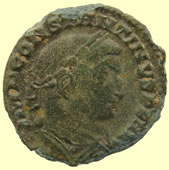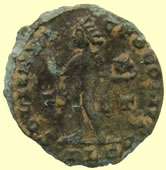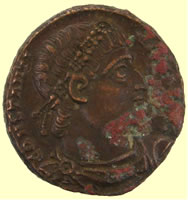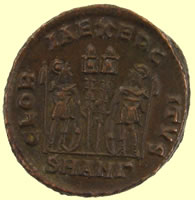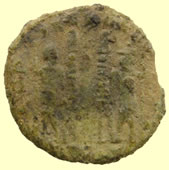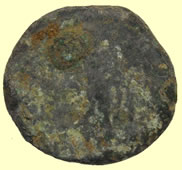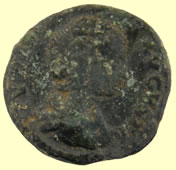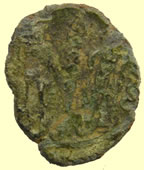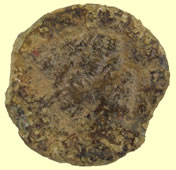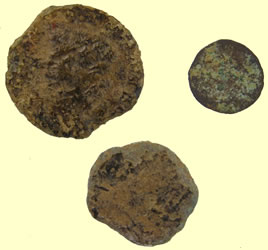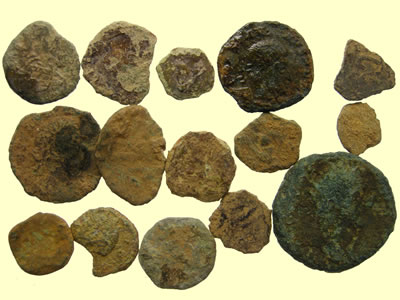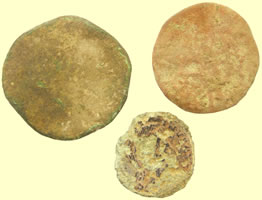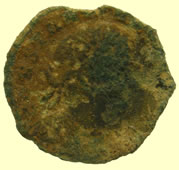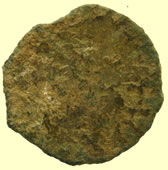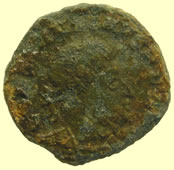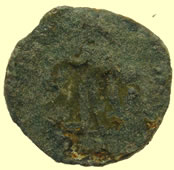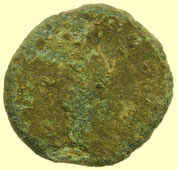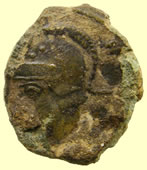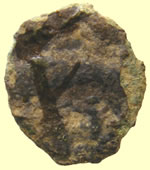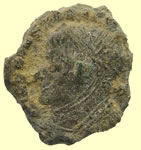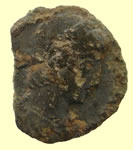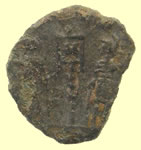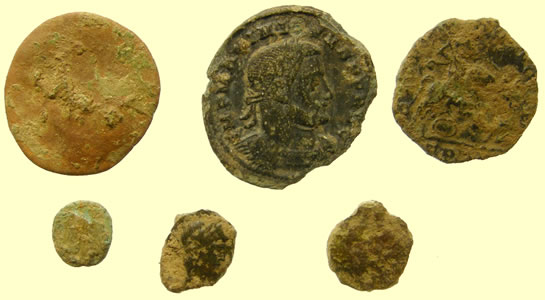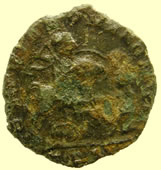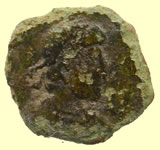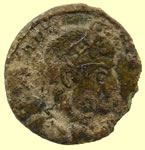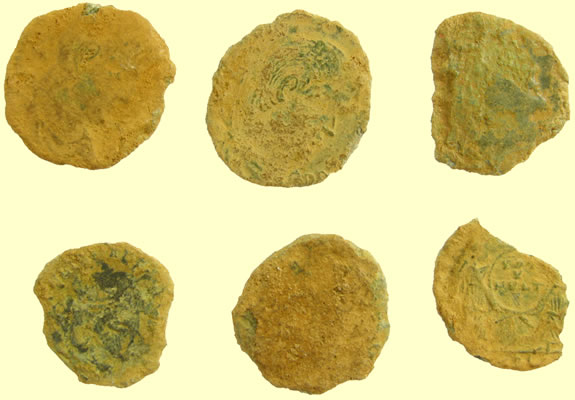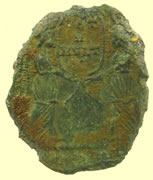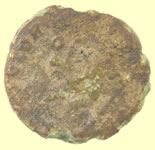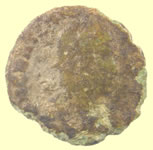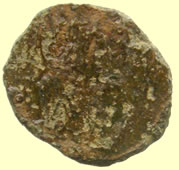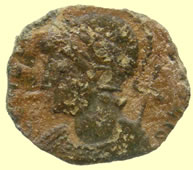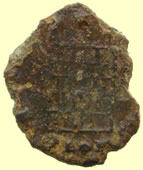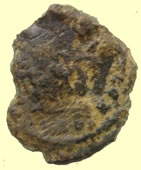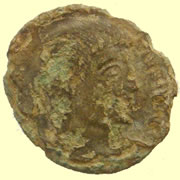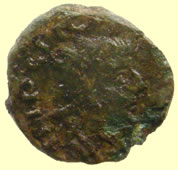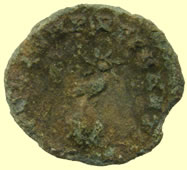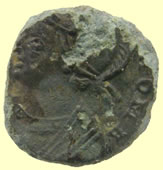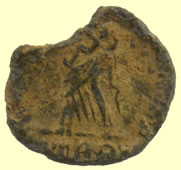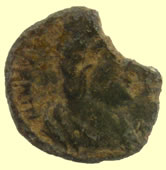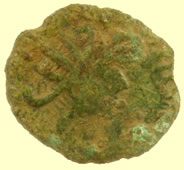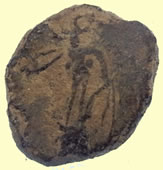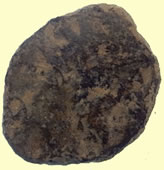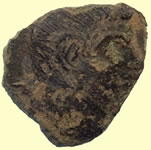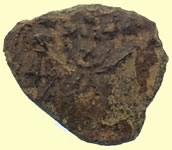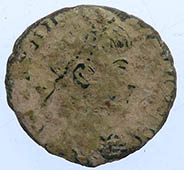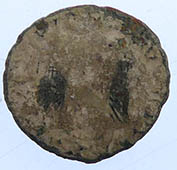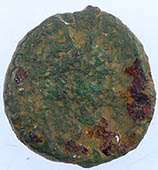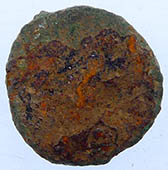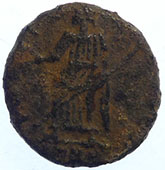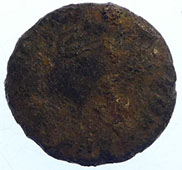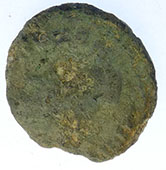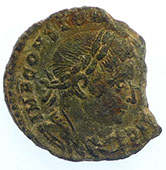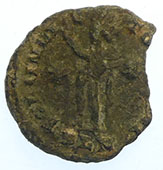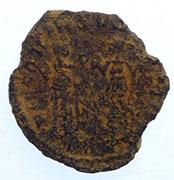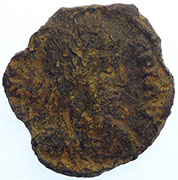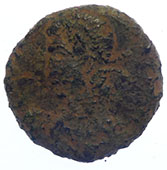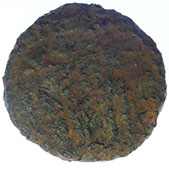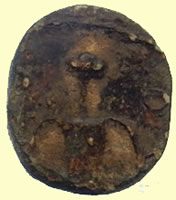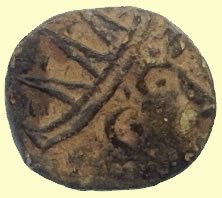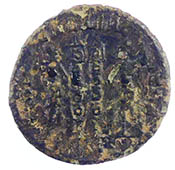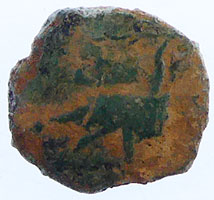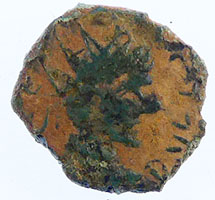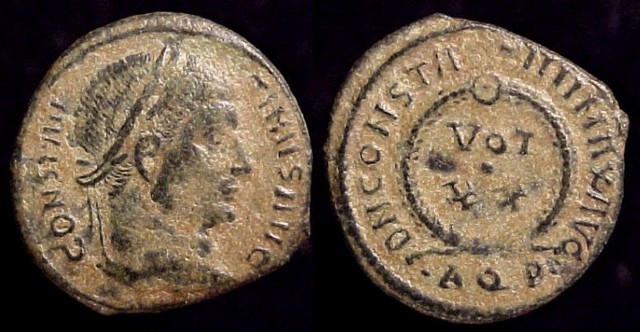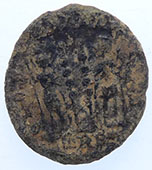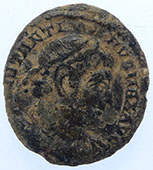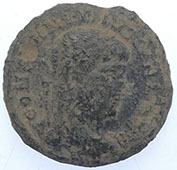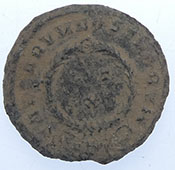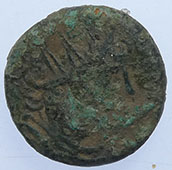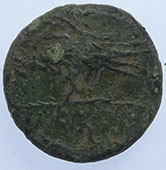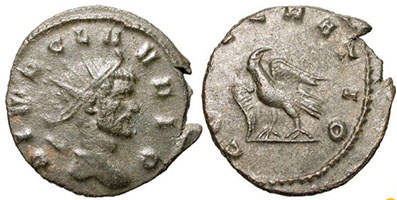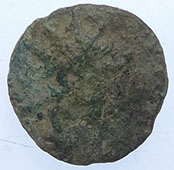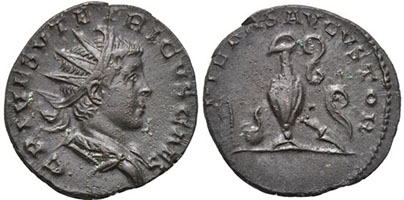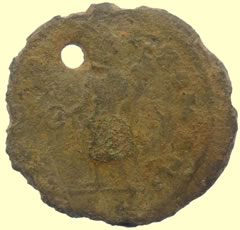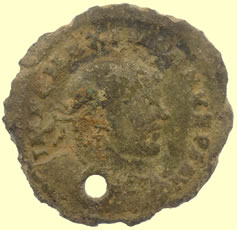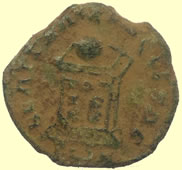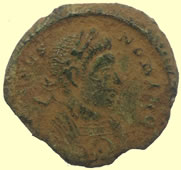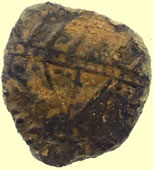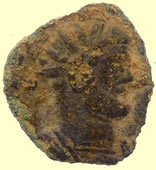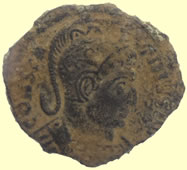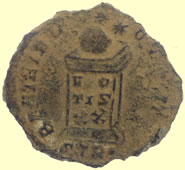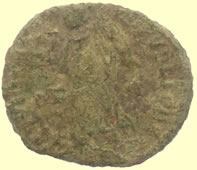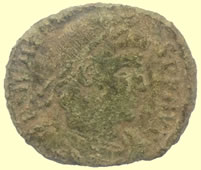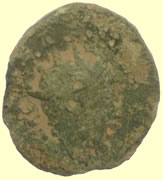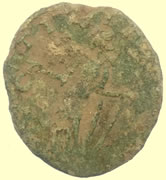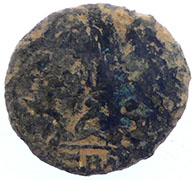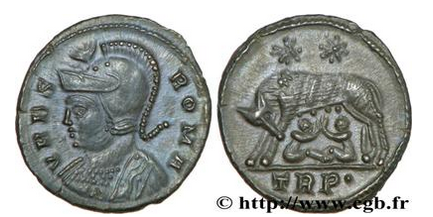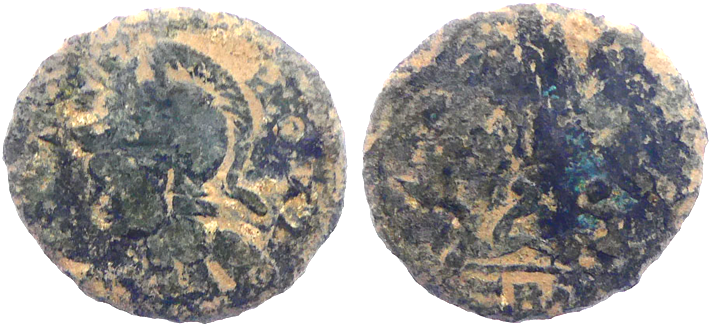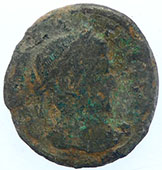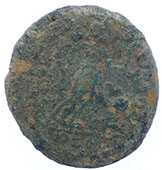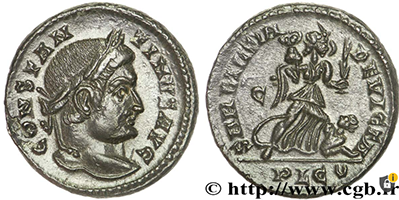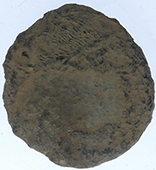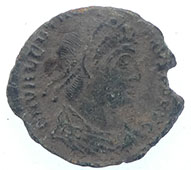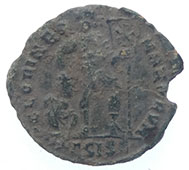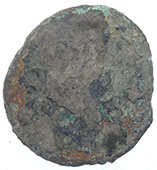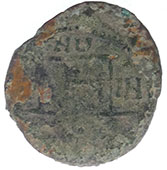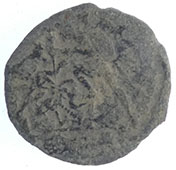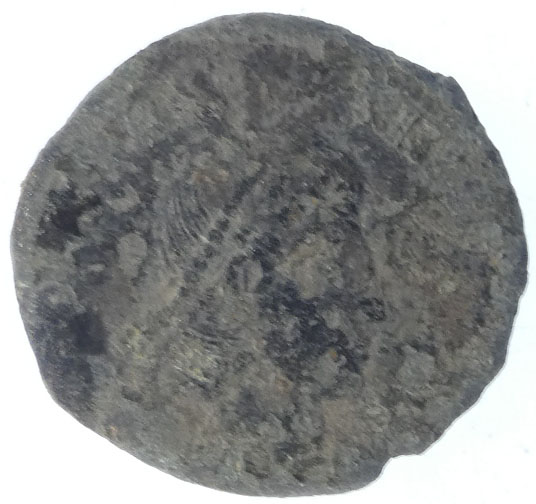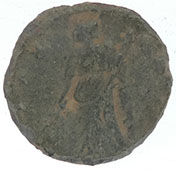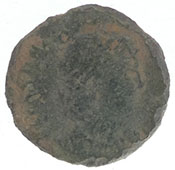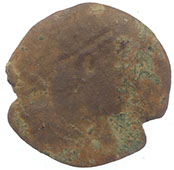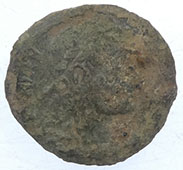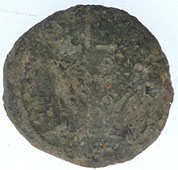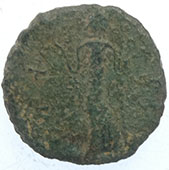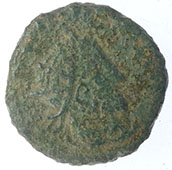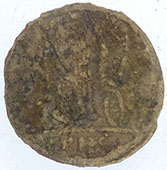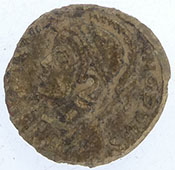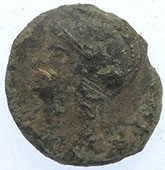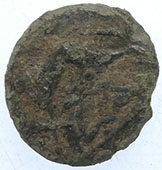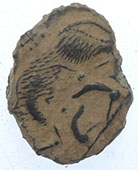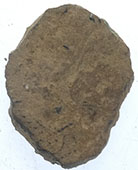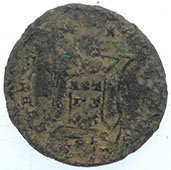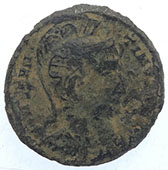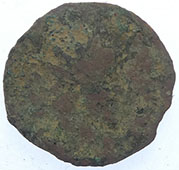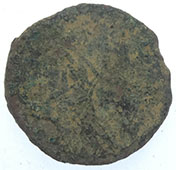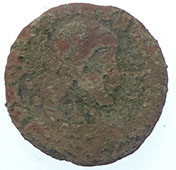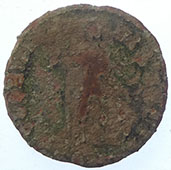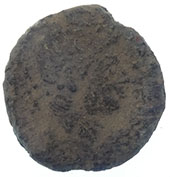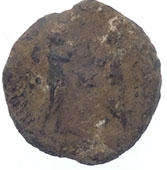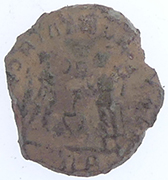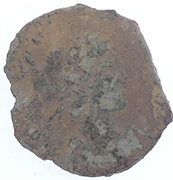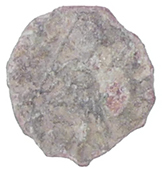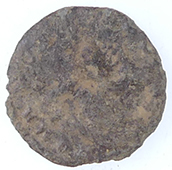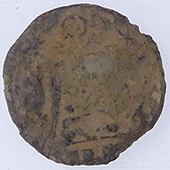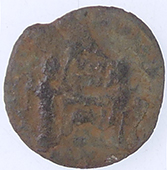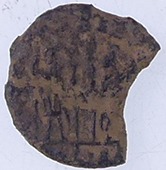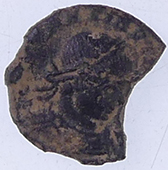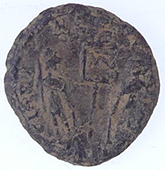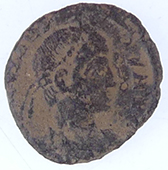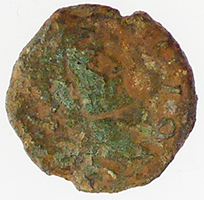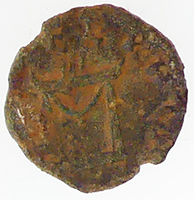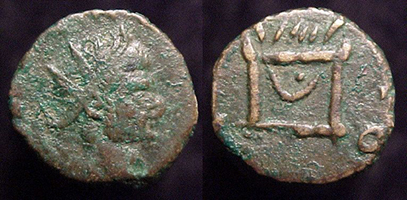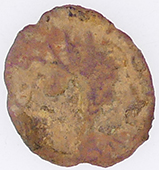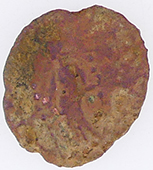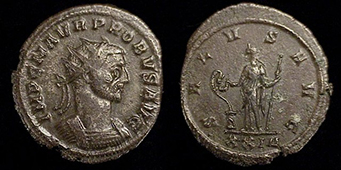

Metal detecting holidays in England with the World's most successful metal detecting club.20 years plus.
Twinned with Midwest Historical Research Society USA.
Roman Bronze coins 3rd to 4th C AD
|
|||||||||||||||||||||||||||||||||
For other Roman coins links For 1st to 2ndC Roman bronze coins click here All comments and ID's under the coins are from Mark Lehman our clubs Roman coin expert
|
|||||||||||||||||||||||||||||||||
4thC House of Constantine Roman bronze sent for ID 3.71g, 22.01mm The Constantine is a SOLI INVICTO COMITI reduced-module follis from Lugdunum. It was rather early in the series of size reductions, so it's still fairly substantial by the standards of the later 4th century, although the follis was nearly the size of a 2nd century sestertius when first introduced - not quite so thick, but similar diameter.
with the field- and mint marks like this
F | T
P L C
It belongs to the issue of 309-10 AD - right at the beginning of Constantine's general acceptance as an Augustus.
catalog: RIC VI Lugdunum 308.
|
|||||||||||||||||||||||||||||||||
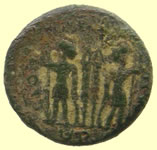 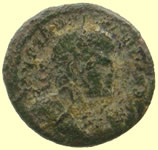 |
|||||||||||||||||||||||||||||||||
The first thing that's clear - oddly enough - is the mintmark. That's distinctive for the mint at Lugdunum and that exact type was used only during the year 332. This type, the 2-standard Gloria Exercitvs, was struck for only 3 people, Constantine I Augustus, Constantine II and Constantius II, Caesars. The issue in telling you any more than that is in the ability to read any of the obverse legend. It's "sort of" visible, but frustratingly unclear - the possibile obverse legeds are: Since it appears there may be a break in the legend above the portrait's head, I will provisionally guess that it's Constantine I - "The Great". But I can't be certain because the legend is frustratingly unclear. So, I can give you the date and mint with complete certainty, but not the emperor. Mark |
|||||||||||||||||||||||||||||||||
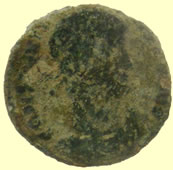  |
|||||||||||||||||||||||||||||||||
Mid 4thC Roman bronze coin sent for ID Unfortunately, Murphy's law of Constantinian legends comes into play on this piece. Although this is clearly a 2 soldiers and 1-standard GLORIA EXERCITVS, dating to 336-340 AD, and even the mintmark is clear enough for me to read without magnification - SMTS[A] - Thessalonica, what we have visible on the obverse is "CONSTAN.......VG" which means this could be any one of the 4 primary members of the family of Constantine the Great who were Augusti at some point. Constantine I or II, Constantius II or Constans - all had legends as Augustus beginning CONSTAN and ending VG on their Thessalonica 1-standard issues.
So there you have it, a datable, mint-specific but otherwise perfectly generic Constantinian Æ3. Mark |
|||||||||||||||||||||||||||||||||
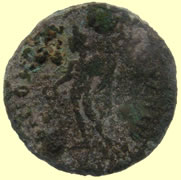 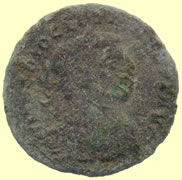 |
|||||||||||||||||||||||||||||||||
3rdC Roman bronze sent off for ID Unless you can make out some letters in the exergue - the area below the "ground line" on the reverse - I won't be able to tell you much more than I have already about this piece. In general, Diocletian is a very important ruler in terms of the coinage as well as being a political innovator - he thought up the tetrarchy system, breaking the Empire down into manageable chunks shared-out between 4 or more Imperials. He completely re-vamped and reformed the Roman economic system during the 280's & 290's. One of his major changes in the coinage was the introduction of the follis - a large (the earliest ones can be upwards of 35mm) billon coin with silvering. This was then the main circulating denomination for the next 50+ years or so, although it underwent an inexorable process of debasement and diminution of size so that the final pieces of this general denomination will be in the vicinity of 15mm and 1.5 - 2.0 gms. If we can read the exergual mint mark (or, in one case, show that there is none) we can then place it to both a mint and a time-range - usually of no more than a year or two. Without the exergual mintmark, just on the basis of size and type, it's likely to be around 300 AD, give or take a few years. Diocletian abdicated in 305 and became one of the few Roman emperors to die in his own bed at home. Mark |
|||||||||||||||||||||||||||||||||
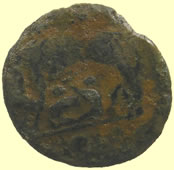 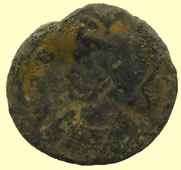 |
|||||||||||||||||||||||||||||||||
You're correct that this coin has a Shewolf & Twins reverse which is typically found on the VRBS ROMA, City of Rome commemorative, reduced-module folles introduced around 330 AD., at the time Constantinople became the official seat of Constantine's government. These have a helmeted and mantled bust of the allegorical personification of the City of Rome facing left on their obverses. At approximately 17mm (although at 1.41gm, it's on the light side) it's most likely from the emissions of c 330-333/5, rather than the later ones of 333/5-337 which tended to be even smaller. At some mints, they were even continued as a type past the death of Constantine in 337, although often paired with a "Vota" or a GLORIA EXERCITVS soldiers & standard reverse rather than the wolf & twins. This atypical use of a subject other than an Imperial bust on the obverse was a convenient political "dodge" for cities which hadn't necessarily declared-for or been brought securely into the fold of one or another of Constantine's sons, who had some "disagreement" about who had inherited what territory or was to rule where, etc.
Unfortunately, the exergual area is too far off-flan for me to be able to make an informed guess as to the city of origin - top seriph-tips of a few letters are visible, but not enough to really be able to tell what was intended.
For a somewhat clearer view of the type, see: http://www.stoa.org/gallery/album165/52_VRBS_CYZ or: http://www.stoa.org/gallery/album165/57_VRBS_TES and as you can see from the first example, these were originally silver-washed, although the silvering very seldom survives to the present day.
Mark
|
|||||||||||||||||||||||||||||||||
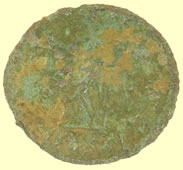  |
|||||||||||||||||||||||||||||||||
4thC Barbarous radiate Roman bronze - sent for ID I'll need to see if there's anything I can tweak out of these images which, frankly, look like the Ishiahara color-blindness test circles in these photos. Yes, it's probably a radiate and if it's primarily Æ or low-end billon, we can date it to the era 265-290 with some certainty without needing to know any more. To get a lot more detail about/from this piece will take some work. |
|||||||||||||||||||||||||||||||||
 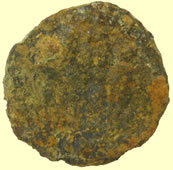
|
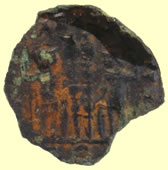 
|
||||||||||||||||||||||||||||||||
 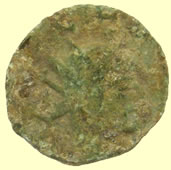 |
|||||||||||||||||||||||||||||||||
Nice detail on this mid 4thC Barbarous radiate Roman bronze - sent for ID This is a posthumous commemorative of Claudius II, Gothicus - 268-270 AD - "DIVO CLAVDIO". These were produced at the absolute nadir of the Empire under Quintillus and at the beginning of Aurelian's reign, and also were extensively copied. For that reason, unless a piece is either exceptionally well-made and oversize, or exceptionally crude, blundered and/or small, it's really difficult to be certain if any given specimen official or not. The Empire was in such a mess at the time that I'm not certain it even matters with this issue.
The reverse type is CONSECRATIO and shows the facade of an altar-enclosure with "eternal flame" burning on top - so you have the reverse image rotated about 120º clockwise of proper orientation.
It's a very common type in general, but since no one's all that sure where to draw the line between official and unoffical origin with these, they're an interesting case-study in how to tell one from the other.
Mark
|
|||||||||||||||||||||||||||||||||
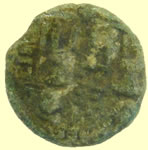 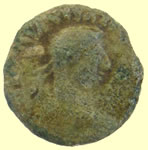
|
|||||||||||||||||||||||||||||||||
Small Roman bronze - sent for ID 12.43mm,1.37g I'm not completely sure this is a regular Roman Imperial issue - there's so little useful detail left on the reverse and although some of the obverse legend seems to be there, I can't make any sense out of it. Then there's the stylistic issues - like the potato-nose, protruberant lips, etc. I suspect this is a contemporary copy of one of the SPES REIPVBLICAE "campgates" of Magnus Maximus or his son, Flavius Victor. This would place it no earlier than the mid-late 380's - or possibly later.
That is my best guess, unless you can make-out something other than a rectilinear structure on the reverse - that's all I can see, but stylistically, it's nothing at all like the typical campgate Æ4's of the era.
Another possiblity might be that it's later than the Roman era and is some local warlord, king or chieftan from the early medieval period.
At any rate, I can't say with authority that I know exactly what it is, except that if it is "Roman", it's rather unlike anything I've seen before - particularly from British digs.
Mark
After closer examination, I'm willing to say this looks a lot like an antoninianus of Carausius, who you probably know was the emperor of the British Roman Empire c 287-293 AD. Looking carefully at what remains of the obverse lettering I think I can see IMP CARAV... I think I can see ML XXI.. in the exergue, which would make it Mint of London, and I can make out a G at the end of the reverse legend. Given the likelihood of any piece from this reign to portray Pax, I'll make a guess that it's the common PAX AVG type with Pax standing left holding an olive -branch and scepter, although Hilaritas and Laetitia are also possibilities.
Mark Since I was a little unsure at first, I posted photos of this piece and asked for input from a few other experienced coin folks.
This is, so far as I can tell, a local, contemoprary copy of a Constantinian GLORIA EXERCITVS (Æ3) 2 soldiers standing, flanking 2 standards. The prototype was produced at all mints across the Empire in c 330-335 AD.
I've seen a number of British-found copies, of "Minimus' and Minissisimus" module, which use as their prototype the issues of the early 330's - and/or the later issues with a single standard between the soldiers.
It's uncertain whom the portrait was supposed to emulate, since I do not believe Jimmy Durante was a member of the family of Constantine, but these were struck for all 4 living male members in that time-frame. It's not too much of a stretch to make-out "...STAN..." or "...STANT..." above the portrait - and that may even be "...CIT..." at 3:00-4:00 on the reverse. I would give you the URL's for some similar pieces in my collection, but my website server is still hors de combat, although the folks in the Classics department seem finally to be trying to do something about it.
Mark
|
|||||||||||||||||||||||||||||||||
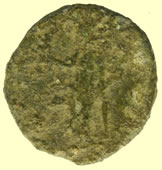  |
|||||||||||||||||||||||||||||||||
4thC Barbarous radiate Roman bronze - sent for ID Claudius II, Gothicus - 268-270 AD. Antoninianus. Reverse is SECVRITAS PVBLICA - which you can tell from the "legs akimbo" pose, reclining at ease against a cippus or short column.
Coming, as it did, at the absolute darkest hour for the Roman Empire (or the darkest hour from which it recovered, at any rate), the reign of Gothicus is notable for the incredibly low standards of production of the coins - at least the Æ/billon antoniniani - so this is really a quite nice specimen, aside from the oxidation.
Mark
|
|||||||||||||||||||||||||||||||||
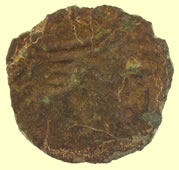 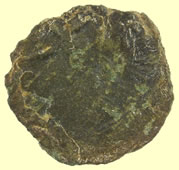 |
|||||||||||||||||||||||||||||||||
4thC Barbarous radiate Roman bronze |
|||||||||||||||||||||||||||||||||
 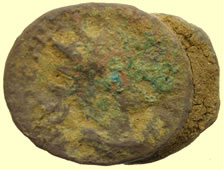 |
|||||||||||||||||||||||||||||||||
Great find 2 mid 4thC Roman barbarous radiate coins stuck togther 2 coins fused together makes it sound as though there must have been a (cracked or broken) pot or (organic material) purse or bag which although it didn't keep water out, more or less held the coins in place until fairly recently - it takes a while for the diagenesis process to fuse coins together. This could be why you're getting a bunch of radiate copies - a somewhat substantial group which was only scattered relatively recently. At any rate, it seems you're digging a mid-late 3rd century horizon at the moment or an area through which a plow-pass scattered a significant number of similar pieces.
The coin which is facing the camera in your photo of the "twofer" looks as though it might be an official piece from one of the later Gallic emperors, probably Tetricus I - I think I can read [IM] P C TET [RICVS...] and the quality of the engraving doesn't seem like the typical crude work of the contemporary copies. I believe that these and their copies circulated side-by-side for at least a part of the time during which they were current, the copies making up for a shortfall of official coin, even from the "local" Gallic Empire. Since you very seldom (if ever, so far as I remember) find coins of the "interim" Roman emperors like Aurelian and Probus whose coins are so common on the continent, that was evidently a time during which the British Isles, Brittany and Northern Europe in general was experiencing a vacuum of interaction with the Roman Central Authority, including the supply of coin.
Mark
|
|||||||||||||||||||||||||||||||||
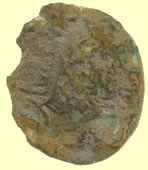 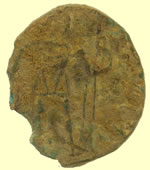 |
|||||||||||||||||||||||||||||||||
4thC Barbarous radiate Roman bronze - sent for ID This appears to be a "garden variety" mid-later 3rd century contemporary local copy - the sort of thing which is liable to be referred to (although I hate the term) as a so-called "barbarous radiate". It's stylistically very interesting in that the stick-figure reverse device is built up out of almost all straight lines and angles, where these generally tend to be made up of curvy or loopy, freehand-engraved lines. I'm going to guess - although with the right hand and the attribute it's holding off-flan it's only a guess - that this is meant to be a representation of PAX - which is by far the most common reverse type for these. Spes and Salus are both fairly popular as well, but neither holds a scepter.
2 coins fused together makes it sound as though there must have been a (cracked or broken) pot or (organic material) purse or bag which although it didn't keep water out, more or less held the coins in place until fairly recently - it takes a while for the diagenesis process to fuse coins together. This could be why you're getting a bunch of radiate copies - a somewhat substantial group which was only scattered relatively recently. At any rate, it seems you're digging a mid-late 3rd century horizon at the moment or an area through which a plow-pass scattered a significant number of similar pieces.
The coin which is facing the camera in your photo of the "twofer" looks as though it might be an official piece from one of the later Gallic emperors, probably Tetricus I - I think I can read [IM] P C TET [RICVS...] and the quality of the engraving doesn't seem like the typical crude work of the contemporary copies. I believe that these and their copies circulated side-by-side for at least a part of the time during which they were current, the copies making up for a shortfall of official coin, even from the "local" Gallic Empire. Since you very seldom (if ever, so far as I remember) find coins of the "interim" Roman emperors like Aurelian and Probus whose coins are so common on the continent, that was evidently a time during which the British Isles, Brittany and Northern Europe in general was experiencing a vacuum of interaction with the Roman Central Authority, including the supply of coin.
Mark
|
|||||||||||||||||||||||||||||||||
  |
|||||||||||||||||||||||||||||||||
4thC Roman barbarous radiate coin sent for ID There's not a lot to go on, but I believe this is an Æ Antoninianus of Victorinus. You're undoubtedly familiar with Tetricus since his coins seem quite common (and quite commonly dug, as well) in Britain. You've sent me photos of a couple of Tetricus pieces in the last few weeks. Victorinus was Tetricus' immediate predecessor as emperor of the Gallic Empire, 268-270 AD. I can't really make out much on the reverse, but I suspect it's one of the "stable of standard personifications". If the raised area corresponds to shoulders of a standing figure, it could be Spes walking left holding a flower in outstretched right hand and hitching hem of skirt with her left . Or, it's possible it could be Pax holding a branch and transverse scepter. It also might be Victory walking left holding a wreath and palm-branch. I'd need to be able either to see a bit of legend or a little more detail on the figure to be certain which. Victorinus is a bit scarcer, overall, than Tetricus. Mark |
|||||||||||||||||||||||||||||||||
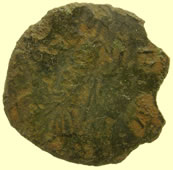  |
|||||||||||||||||||||||||||||||||
4thC Roman coin - sent for ID 1.70g, 19.26 This one is surprisingly large (although not particularly heavy) for the genre - radiate contemporary copy. This example is adequately far removed from official origins that the legend has been reduced to a decorative element - a meaningless border comprised primarily of "I's". Since the portrait appears to be bearded, I'd supppose a coin of Victorinus, Tetricus I or Claudius II supplied the prototype. The reverse figure is adequately vague that about all we can do is guess at which personification or deity may have been intended, but on the strength of the transverse scepter and the relatively sparse, widely spaced "lettering", I'd be willing to guess that PAX AVG may have been what the engraver had in mind. The general time-frame would be approximately 270-280 AD. give or take a couple of years. Mark |
|||||||||||||||||||||||||||||||||
17.45mm,3.05g |
|||||||||||||||||||||||||||||||||
Gobsmacking Roman coin dug - When I saw this last night I was staggered to see a coin come out of the ground in this condition. Cal Dan wandered onto a uncultivated grass spot on a great Roman area and popped it. I suspected one of 3 things, he made it himself, he clipped the top off a pot or it had a hugh gold content. I dropped Mark an email asking the same questions and the reply is facinating. What a magnificient Roman coin, stunning. The guys are going to give this grass we never hunt a good pounding shortly to check if there are more out there. It might contain one or two percent silver, at best. Nothing like a soldiers and standards GLORIA EXERCITVS was ever struck in gold. Also, even as horribly as they debased first the silver, and later even the bronze was adulterated with lead and even iron scraps, some peices were struck in "virgin bronze" of pure copper & tin with a tiny admixure of silver. Try a strong magnet on some LRB's sometime - you may be surprised how many of them will respond in some observable way to a magnet, indicating a significant iron content.
As beautiful as this piece is compared to what you usually see coming out of the ground, this is just an example of 1st, the mint hitting its quality-control goals - the Romans conceived of an "ideal coin" which would be a regular, thin cylindrical section disc, perfectly struck and centered on-flan. As you know, it very seldom worked out that way. They almost never achieved their own ideal.
This is also what happens when a coin quickly develops a thin layer of oxidate which "seals" it from most further degradation. I say most because as you can see from the obverse, there are some smallish areas which experienced some further oxidation. This coin was also well-struck and centered perfectly on a nearly perfect cylindrical-section disc-shaped flan. The dies were newly cut so all the detail the engraver intended was still present on the dies to be represented on the coin.
This is the difference between a coin which a high-end sales venue gets, well, I don't even know, but I've heard of some very attractive common LRB's bringing as much as US $100 lately - and another, completely authentic and ancient coin of the exact same type - perhaps struck with the same dies - but weakly struck, off-center and at an angle of some degrees off parallel planes, on a raggedy, debased flan with who-knows-what junk in the alloy. It's "Friday afternoon", eveyone's tired, the dies are worn out, but you're not going to break-out a new set of dies this late in the day, and the quality goes way down - you find those coins in a $1 apiece pick-box at a flea market.
Occasionally, they really got it right - and those specimens are the exception rather than the rule.
Also, your coin, like the 2nd coin above, is a product of the mint at Antioch, which for some reason or in some manner always seemed to turn out a superior product compared to the Balkan & southern European mints, etc.
Mark
PS - Your coin is Constantine I, "the great", mint of Antioch, RIC VII 85, 330-335 AD.
|
|||||||||||||||||||||||||||||||||
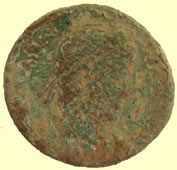 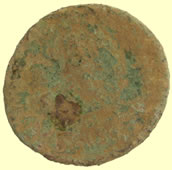
|
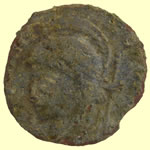 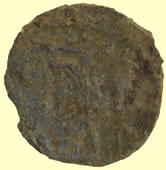
|
||||||||||||||||||||||||||||||||
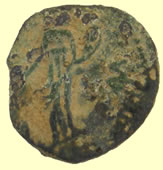 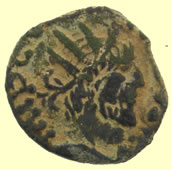
|
|||||||||||||||||||||||||||||||||
Mid 4th Barbarous radiate Roman coin sent for ID This piece appears to be a contemporary copy using a Tetricus I (or possibly Victorinus) billon antoninianus as its prototype. I'm not 100% certain what personification was intended on the reverse, although both Moneta, holding scales and cornucopiae and Hilaritas, holding palm-branch and cornucopiae, are both possibilities. There are a few other personifications, Laetitia, Providentia & Uberitas among the most common, who appear with some regularity in the Gallic Imperial series and would also be holding cornucopiae, so since whatever this lady holds in her right hand is off-flan, we'll have to settle for a generic description like, "Female Personification standing left holding [?] and cornucopiae"
Since the legends are not completely illiterate and the art work is really pretty good for these, my guess is that it would be just about contemporary with the prototypes - ie: 270's AD - and very unlikely to be much later than the 280's, since London and the as yet uncertain "C" mint produced large quantities of coin for Carausius beginning in 287. London switched to production of Imperial types immediately after the successful campaigns of Constantius (I) in the 290's, so the vacuum of regal coin which these pieces addressed generally began around 275 and had been relieved first by Carausius (and Allectus) then Constantius by the late 280's and into the early 290's.
Mark
|
|||||||||||||||||||||||||||||||||
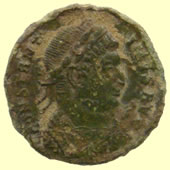 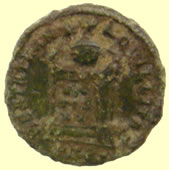 |
|||||||||||||||||||||||||||||||||
4thC Roman coin sent for ID The 3rd piece is Constantine I (The Great, 307-337 AD.), a reduced-module Follis. Your photography is not quite up to its usual standards on this one - particularly the reverse, so I can't be certain which mint it's from, but I think I see TRS• in the exergue. If so, it's from the mint of Trier. The reverse type, BEATA TRANQVILLITAS (Blessed Tranquility!) with 3 stars above the Orbis Terrarum atop a short altar inscribed VO / TIS / X X, dates to approximately 321-323 AD. If I could get an accurate read on the letters (and possibly a dot or dots, and/or crescent) in the exergue, I could probably pin it down closer - to a single year. On this coin, Constantine is portrayed in what is called "Consular Style", wearing Trabaea (Imperial mantle) rather than the usual cuirass & drapery, and holding an eagle-tipped scepter. This same type was struck at all the Western and Northern mints in addition to Trier (including London) during this approximate time-frame, early 320's AD.
Mark
|
|||||||||||||||||||||||||||||||||
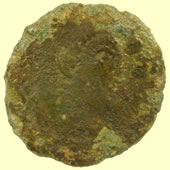  |
|||||||||||||||||||||||||||||||||
4thC Roman bronze coin sent for ID The large Christogram reverse is typically associated with Magnentius & Decentius, although it is also known for Constantius II. I'm pretty sure this is one of the pair of brothers (probably Magnentius as his coins are a lot more common then Decentius') - they're always portrayed with no headgear and rather silly-looking "mullet" hairdos. I can't give you a mint on this one - it's not clean enough - and I suspect the exergue is off flan due to being off-center "to the South" a bit. Their time frame was 350-353 AD. and all their coins were from Western mints - they were not recognized in the East.
Mark
|
|||||||||||||||||||||||||||||||||
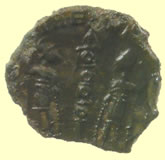 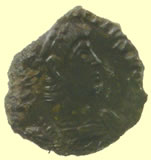
|
 
|
||||||||||||||||||||||||||||||||
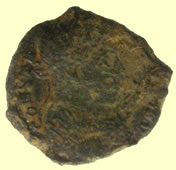 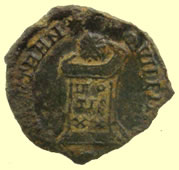 |
|||||||||||||||||||||||||||||||||
4thC House of Constantine Roman bronze sent for ID The BEATA TRANQVILLITAS - 3 stars above a globe atop an altar inscribed VO / TIS / XX - of Constantine I appears to be from the mint at Trier. This is one of the earlier mass issues in the "Constantinian" era. Dating to the early 320's, they come just after the VLPP's and VIRTVS EXERCIT types and immediately precede the "campgate" types. This one is clear enough to show the "bands" on the globe and make it relatively certain to be meant to represent the "Orbis Terrarum", or the celestial sphere surrounding the Earth. Mark |
|||||||||||||||||||||||||||||||||
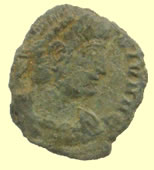 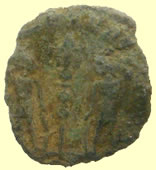 |
|||||||||||||||||||||||||||||||||
4thC House of Constantine Roman bronze sent for ID There isn't quite enough detail on the reverse to be sure which mint it's from, but the single-standard GLORIA EXERCITVS here names Constantine II in a relatively uncommon obverse legend ending "...IVN N C" Only Constantine II ever had IVN in his title and the use of N C instead of NOB C or NOB CAES is limited to a few of the Western European mints - Trier, Arles & Rome. Mark |
|||||||||||||||||||||||||||||||||
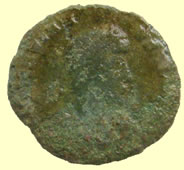 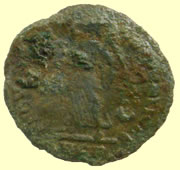 |
|||||||||||||||||||||||||||||||||
4thC House of Constantine Roman bronze sent for ID The second on this page, with reverse type, Victory walking left holding wreath and palm, is from after the end of the Constantinian era. I believe it names Gratian, 367-383 and I also believe it's from the mint at Lyon, although the mint mark isn't very clear and the GLORIA ROMANORVM & SECVRITAS REIPVBLICAE types introduced in the Valentinian Dynasty were among the first to employ a really complex field-and-mint mark control system, so there are an enormous number of combinations for each mint combining various marks in the fields and exergue.
Mark
|
|||||||||||||||||||||||||||||||||
 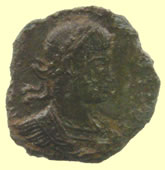 |
|||||||||||||||||||||||||||||||||
Mid 4thC House of Constantine Roman bronze coin sent for ID - 1.44g, 16.31mm I'm not going to be able to say with certainty, but on the basis of the bust, this appears to be Constantine II as Caesar, although it could be his brother Constantius II. The GLORIA EXERCITUS, 2 soldiers flanking 2 standards type was struck at all mints during the period 330-335/6 AD. The exergual mint mark on this one is a bit unclear, but I think it's from the mint at Siscia - modern-day Sisak, near Split in Croatia.
Mark
I'll add a speculative attribution to mint based on some mint mark tables I have access to. If the 3rd character is a dot (as it appears it may be) chances are good this is a product of the mint at Trier. It seems as though - being about as close as any Roman mint of the era - a disproportionate number (for any other location) of the AE's you find are from Trier.
You presumably have the coin "in-hand" - if you'll look to see if the exergual mint mark is TR•S (as it appears it may be) you may be able to confirm or refute this guess.
Mark
|
|||||||||||||||||||||||||||||||||
  |
|||||||||||||||||||||||||||||||||
Mid 4thC Barbarous radiate Roman bronze coin |
|||||||||||||||||||||||||||||||||
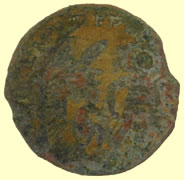 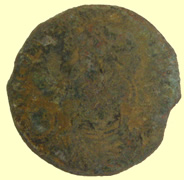 |
|||||||||||||||||||||||||||||||||
Very unusual Roman copper coin sent for ID |
|||||||||||||||||||||||||||||||||
  |
|||||||||||||||||||||||||||||||||
Mid 4thC Barbarous radiate Roman bronze coin sent for ID |
|||||||||||||||||||||||||||||||||
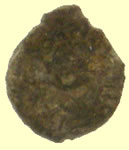  |
|||||||||||||||||||||||||||||||||
Tiny Roman minim coin sent for ID At first glance, at least, it seems similar to the very late Roman nummi - typically from mid- to late-5th century - the single denomination, the Nummus, 40 of which made a Byzantine follis (with "M" mark of denomination reverse) Although they usually had a portrait on the obverse, and at least part of a legend - they're so small that virtually none of them ever has anything like a complete, legible obverse legend - and the reverses were monograms of the rulers' names.
Not to say that this might not be a Saxon piece in imitation of the types or styles in use on the continent, since the various Gothic successors to the Roman Empire in the West also imitated the coins of the Byzantine Roman Empire - although generally in precious metals - they weren't real big on token coinage as a concept so they tended to make and use tiny silver & gold pieces for small change in the few places coins were still used.
Compare your piece to this Marcian - probably the clearest example I have of an Æ4 with monogram reverse.
So your piece might be Roman, or it might be a contemporary copy of a Roman coin, or it cold be from a Gothic or Saxon series which, in general, imitated Roman/Byzantine types.
I'll be curious to see a clearer close-up - I can then try comparing the reverse against the various monogram charts.
Mark
|
|||||||||||||||||||||||||||||||||
 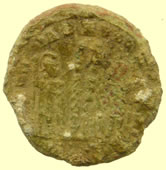 |
|||||||||||||||||||||||||||||||||
4thC House of Constantine Roman bronze coin - sent for ID That would be Constantine I - "The Great" - (307-337 AD) styling himself as "CONSTANTINVS MAX AVG" on the obverse with a double-standards GLORIA EXERCITVS reverse. The double-standard GE's date to ~330-335 at all mints.
I haven't been able to tease any detail out of the exergual mint mark, so I can't tell you which mint produced it, but it seems as though the mints of Trier, Lugdunum and Arles are heavily represented in the mix of Imperial Æ's you find.
Mark
|
|||||||||||||||||||||||||||||||||
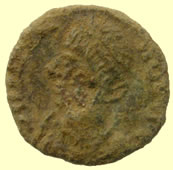 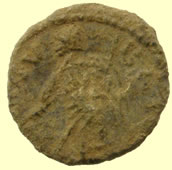 |
|||||||||||||||||||||||||||||||||
Roman bronze coin sent for ID I suppose this might be the one you were asking about. This actually isn't "the typical 4th century Æ" - it gives me the impression that it is an unofficial, local product. In fact, I'm not even certain what the prototype was supposed to be. It's interesting because generally it's easy to tell what the local mints were copying. This might have started out trying to be a PAX reverse, but what it wound up being I'm not altogether sure - also the portrait is wrong on a number of considerations. It does not look a though it has literate legends, either - the "legends", particularly on the obverse, seem to have been reduced to a design element - a "decorative border" if you will.
Mark
|
|||||||||||||||||||||||||||||||||
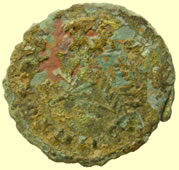 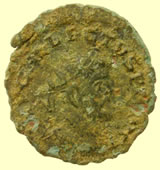 |
|||||||||||||||||||||||||||||||||
Roman bronze coin - sent for ID This piece appears to be a Quinarius of Allectus - not unlike one you sent a photo of both sides recently, although not in such nice shape. This one is also from the "C" mint - Camulodunum, or whatever city the C represented. This shows a galley being rowed and your photo is rotated about 110º counter-clockwise of correct orientation - the mast should be sticking straight up, but is currently pointing towards 8:00.
Mark
|
|||||||||||||||||||||||||||||||||
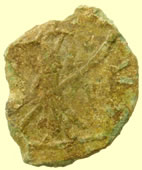 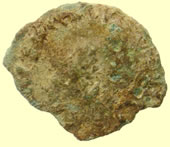 |
|||||||||||||||||||||||||||||||||
Roman bronze coin - sent for ID I can't tell much from the obverse, but given the posture of the personification on the reverse and the transverse scepter, I'm going to make an educated guess that this is most probably a PAX AVG type. Unfortunately that doesn't give us much of a hint about who might be on the obverse, since the PAX AVG reverse was one of the most common types throughout the age of Antoniniani - the 2nd half of the 3rd century - and struck by every ruler who struck the denomination.
I'd also say that depending on the size, this piece generally gives me the impression that it's not an official mint product, rather a contemporary copy.
Mark
|
|||||||||||||||||||||||||||||||||
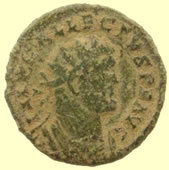  |
|||||||||||||||||||||||||||||||||
Roman bronze coin sent for ID
2.83g, 18.50 As you can easily read, this is a coin of Allectus, 293-6 AD., the unsuccessful successor to the far more savvy British pretender, Carausius.
This piece is called a "Quinarius" - generally a term applied to a half-denomination - although what the difference might be between an Antoninianus and this radiate "Quinarius", I'm not altogether sure. It may be that this is an artificial distinction imposed through classification by later analysts who felt these smaller coins must be of a lower denomination. This piece with reverse type: VIRTVS AVG, galley left, and QC in exergue, is attributed to "Clausentum?" by Sear, to Camulodunum by RIC - same place, two different names? Or two different places? I really don't know enough about Roman-era British Geography to say - you can probably fill in the blanks here. There are several sub-types known, based on number of oars, etc.
It's a fairly common piece, but as you're probably aware, coins of the British Roman Empire, 287-296, are highly sought-after by modern-day British collectors. Here's a "clean" specimen, although displaying a bit more wear, of the same type from my own collection - http://www.stoa.org/gallery/album85/ML_09_Allectus_Virtus_ant2
Mark
PS - Unless I am mistaken, the huge Lord Selborne Blackmoor hoard was thought to be Allectus' war chest, buried for safekeeping just before his ultimate defeat by Constantius I.
|
|||||||||||||||||||||||||||||||||
  |
|||||||||||||||||||||||||||||||||
Roman bronze coin - sent for ID This is a SOLI INVICTO COMITI (Sol, the Invincible, protector) of Constantine I, "The Great". This is a follis with module reduced from the large Æ1-2 coin introduced by Diocletian, but still larger than the Æ3's which would follow. This is from the mint in Trier and dates to the period 310-313 AD.
Mark
|
|||||||||||||||||||||||||||||||||
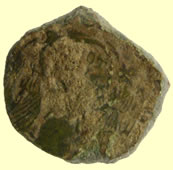  |
|||||||||||||||||||||||||||||||||
Roman bronze coin - sent for ID |
|||||||||||||||||||||||||||||||||
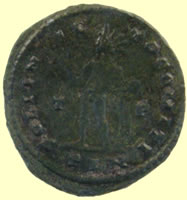 
|
|||||||||||||||||||||||||||||||||
Can Ron cleaned up his Roman and it is one of the best I have ever seen dug - mint , just sent it for ID |
|||||||||||||||||||||||||||||||||
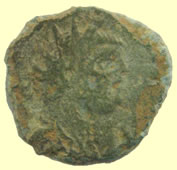 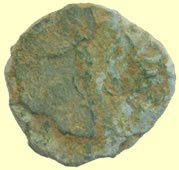 |
|||||||||||||||||||||||||||||||||
Mid 4thC Barbarous Radiate Roman bronze coin |
|||||||||||||||||||||||||||||||||
  |
|||||||||||||||||||||||||||||||||
Roman bronze coin - sent for ID |
|||||||||||||||||||||||||||||||||
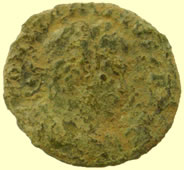 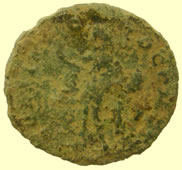 |
|||||||||||||||||||||||||||||||||
Roman bronze coin - sent for ID |
|||||||||||||||||||||||||||||||||
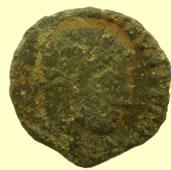 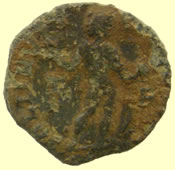 |
|||||||||||||||||||||||||||||||||
Roman bronze coin - sent for ID It's difficult to tell if there's anything unusual about it, but it is of the same general type as that beautiful reduced follis from the London mint you sent yesterday - SOLI INVICTO COMITI - with radiate Sol standing left raising a hand and holding up a globe. These were struck pretty much across the entire Empire at the time ~ 310-315 AD.
I'd have to check to be sure whether or not this type was struck at every Imperial mint, but it was certainly struck in all the European mints.
Mark
|
|||||||||||||||||||||||||||||||||
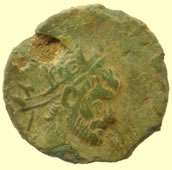  |
|||||||||||||||||||||||||||||||||
Roman bronze coin - sent for ID This appears to be an official-issue posthumous commemorative CONSECRATIO, "billon" (more like Æ, actually) antoninianus of Claudius II, Gothicus. He was the elderly successor to Gallienus in the Roman Principate and ruled for 2 years, 268 until his death in 270. His posthumous coins may well outnumber his lifetime issues. This was also one of the most copied prototypes for so-called "barbarous radiates" - the very common local, unoffically or only semi-offically produced emergency currencies which filled-in for regal coin while the Empire was tottering on the brink of collapse in the mid 3rd century.
This piece appears to be official, but the best of the "barbarous" work is often of higher artistic merit than the work produced by the mint in Rome at this point in time, and it can be very difficult to make a determination with assurance whether or not any given specimen is official or a contemporary copy. Looking for hallmarks like evenly sized and spaced letters in the legends, and a similar level of work between obverse and reverse will usually tend to indicate whether a piece is official or not, but I have been told that to be certain, comparison with items in the collection in the possession of Dunbarton Oaks is generally considered the "yardstick" against which workmanship on this sort of item is judged.
Mark
PS - this piece is a typical "uncertain" origin piece opf this type - http://www.stoa.org/gallery/album106/ML_13_Claud_II_Consecratio_Altar1
by clicking on the arrows in the upper right corner of the frame, you can advance forward through a number of pieces of similar "questionable" origin which span the stylistic range between almost definitely official and certainly unofficial, including several pieces from the huge Blackmoor Hoard.
|
|||||||||||||||||||||||||||||||||
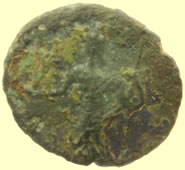 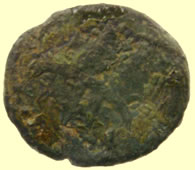 |
|||||||||||||||||||||||||||||||||
Roman bronze coin - sent for ID official Gallic Empire Ant, or a contemporary copy of one (so-called "barbarous radiate") in very good style |
|||||||||||||||||||||||||||||||||
  |
|||||||||||||||||||||||||||||||||
4thC Barbarous radiate Roman bronze sent for ID This one is definitely not of official origin - it's a local contemporary copy. I'm not certain what prototype the engraver had in mind for the reverse - possibly AEQVITAS holding scales (off-flan) and cornucopiae, shown as vertical "tubes". Pax and Spes are generally the most copied types, although Victory and the priestl implements types are seen fairly often as types for these copies.
|
|||||||||||||||||||||||||||||||||
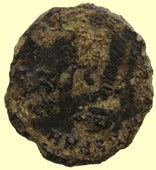 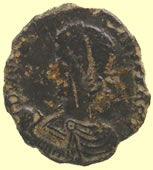 |
|||||||||||||||||||||||||||||||||
4thC Roman coin sent for ID This piece, despite the surviving features being so bold, seems so stylistically unusual that I'm afraid this also appears likely to be a contemporary copy. The bust appears to be bare-headed, but no useful part of the obverse legend is legible, and although official coins of the few rulers who were portrayed bare-headed (Constantius Gallus Caesar, Julian II as Caesar, Magnentius, Decentius and Nepotian) have a only a relatively small number of reverses with which they're associated, the reverse of this piece doesn't seem to have recognizeabe features of any of them. There is a fragment of legend which might be part of FEL TEM ] P REPAR [ATIO (?) but that doesn't seem to line-up in correct orientation for any of the FEL TEMP reverse types rulers in this group used.
Maybe it's just me, today, but I can't make any other sense out of that reverse at all. In fact almost all the photos you've sent in the last couple of days fail to resemble any of the specific types they'd need to be, based on what features are clearly visible. Mark
|
|||||||||||||||||||||||||||||||||
 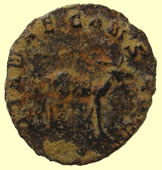
|
|||||||||||||||||||||||||||||||||
Cracking condition Roman bronze sent for ID 19.27, 1.92g
This one, in case you couldn't read it, is an antoninianus of Gallienus (sole reign, 26-268 AD) this belongs to the so-called "Zoo" series of coins with various animal reverses.
This one has a reverse legend of DIANAE CONS AVG and shows an antelope or a stag (elk) (I'm not completely sure which) walking right. A nicer specimen (I happen to be working with a Gallienus zoo collection at the moment)
w/ antelope - http://www.stoa.org/gallery/album430/10_CR_GAZOO -
This series, naming various deities - Apollo, Diana, Hercules, Jupiter, Liber/Bacchus, Neptune & Sol was issued in the last couple years of Gallienus' reign 267/8
Mark
|
|||||||||||||||||||||||||||||||||
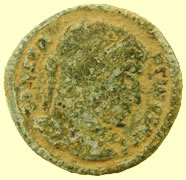 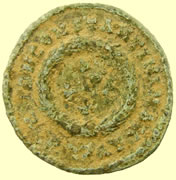
|
|||||||||||||||||||||||||||||||||
Unusual Roman bronze sent for ID 20.75mm,3.22g Constantine I "The Great" (307-337) - this AE3's reverse has "D N CONSTANTINI MAX AVG" around a small wreath in which is the Vota vow "date"- "VOT / XX" It also has a somewhat unusual obverse legend-break - "CONSTA - NTINVS AVG" - they're usually broken more symmetrically.
I can't read the mint mark - if this cleans up at all and we can read the exergue (in this photo, the reverse is rotated 45º clockwise of proper orientation - the mint mark would be at the bottom, under the wreath-ties) I can tell you where it's from - in general though, the "when" is about 320-324 (it wasn't unusual for emperors to "anticipate" their vows by half a decade or more.
If I could see the mint mark, I could say both where it was struck and narrow-down the time frame to a year or a few months, depending.
Mark
|
|||||||||||||||||||||||||||||||||
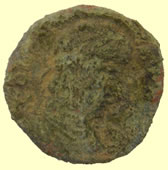

|
|||||||||||||||||||||||||||||||||
4thC Roman bronze coin - sent for ID either Constans or Constantius II - the reverse type, VICTORIAE DD AVGG Q NN - 2 victories facing each other holding wreaths - was only struck in 347 & 348 so it's a good type for dating a site. The obverse is too badly compromised for me to tell from the photo whether it's Constans or Constantius - nothng particularly special about either one, they were brothers and sons of Constantine I "The Great". Constans would live another 2 years and Constantius another 15 or so, but they were petty much "interchangeable" at this point in time, except that one dealt with the western part and the other the eastern part of the Empire. Mark |
|||||||||||||||||||||||||||||||||

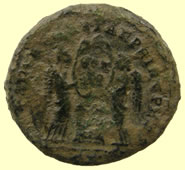
|
|||||||||||||||||||||||||||||||||
4thC Roman bronze sent for ID The two at the top are common Constantinian family types - the 2nd is definitely a 2-standard GLORIA EXERCITVS - the one at the top, I'm not as sure what's going on - is it two standing figures? - if so, it might be a VICTORIAE LAETAE PRINC PERP with 2 Victories holding a shield over a short column, or possibly a Gloria Ex, although it doesn't strike me immediately as a Gloria Ex, I suppose it could be a single-standard type.
The coin on the bottom, however, is unusual - it has AVGVSTA (I think) spelled-out and so is earlier - probably early 3rd century - let me do some research and see who I come up with - I think I see IVLIA on the left, and it could be Domna, although it doesn't much look like her - and I'm curious about the diameter of that one, too - bigger than 18mm, right? - because if it's in the 18mm vicinity, then it's probably a so-called "Limes Denarius".
Mark
|
|||||||||||||||||||||||||||||||||
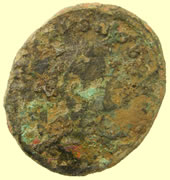
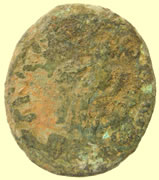
|
|||||||||||||||||||||||||||||||||
27.74mm, 7.81g This appears to be a GENIO POPVLI ROMANI follis of either Galerius as Caesar or Maximinus II as Caesar - this is a little earlier than most of the 4th century material you seem to turn up. This would date to about 305-310 AD. I can't quite read the mint mark - it could be London - but it's generally more likely to be a Western (European) mint rather than an Eastern mint. Mark
|
|||||||||||||||||||||||||||||||||
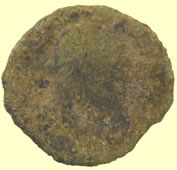
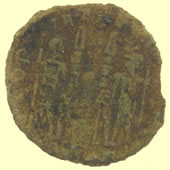
|
|||||||||||||||||||||||||||||||||
Roman bronze sent for ID This one is a two-standard GLORIA EXERCITVS - without a clear obverse legend, I can't say for whom it was struck - and there are at least 4 possibilities - Constantine I and his three younger sons. This type generally dates to about 330-335 AD. These are contemporaneous with the city commemoratives for Rome and Constantinople (like the CONSTANTINOPOLIS you sent earlier today) In about 335, the double standard between the soldiers was changed to a single standard. The single-standard reverse type continued to be used on and off for another 5-10 years.
Mark
|
|||||||||||||||||||||||||||||||||


|
 
|
||||||||||||||||||||||||||||||||


|
|||||||||||||||||||||||||||||||||
|
|||||||||||||||||||||||||||||||||
Constantius II If it's the soldier & horseman type, it's from around 355-259, if it's the emperor & galley type, it's more like 350-53. Mark |
|||||||||||||||||||||||||||||||||
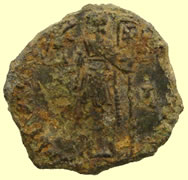
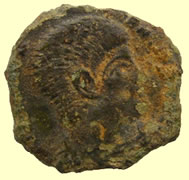
|
|||||||||||||||||||||||||||||||||
Another Roman hoard coin sent for ID 20.22mm, 3.47g
|
|||||||||||||||||||||||||||||||||
Mass Steve's 18 Roman hoard coins sent for ID # 25 appears to be a Dupondius of the Antonine Era - I believe I see the points of a radiate crown on the portrait, the size and weight are consistant with dupondii of that era. Most likely Antoninus Pius (138-161) - the reverse is too far gone to say more than that it's a standing figure - the reverse legend seems to end in "...COS III" dating it, most likely, to the time of Antoninus' 3rd consulship, 140-145 AD. It might be COS III, however, in which case, it would date it from 145-161.
#23 & # 24 are both Constantinian-era pieces, both Folles -
on # 23 I can make out "...CONSTAN..." on the obverse and not very much else - I can't figure out what the reverse is doing - 4 members of the Constantine clan are potential suspects (Constantine I & II, Constans & Constantius II) - without knowing the reverse type, I can only estimate a date roughly, say 315-325 AD.
# 24 has a little more going for it, I'm pretty certain that it's Constantine I, and since the reverse type is one of the IOVI CONSERVATORI series of reverses with Jupiter standing left, holding a small figure of Victory, on a piece of this size, you can say approximately 313-318 AD. with some confidence.
Mark
|
|||||||||||||||||||||||||||||||||
|
|||||||||||||||||||||||||||||||||
Coin 22 (330-337 AD) Roman coins sent off for ID Coin # 20 appears to be a contemporary copy of a mid-3rd century antoninianus. Some folks call these "Barbarous Radiates", although I think that's a completely inappropriate name and mindlessly continues the narrow-minded artistic prejudices of our Victorian forbears. The folks who made and used these coins were no more barbarians than were the makers and users of the coins which they copied - in fact, they tended to be the most civilized residents of an area. These coins typically were an "emergency currency", not unlike Conder Tokens or US Civil War or Hard Times Tokens. When no official coin is reaching an area the economy of which is normally facilitated by commonplace use of coinage, local substitutes - usually in imitation of familiar types - almost inevitably arise. These pieces were not made to decieve, (and so are NOT "counterfeits"), rather to take the place of Regal Coinage which had become unavailable due to hoarding and/or attrition.
This piece is not in good enough condition for me to be sure what was being copied, although the "PAX AVG" and "SPES AVG" reverse types were overwhelmingly popular on 3rd century contemporary copies and the standing figure's raised arm might be holding an olive-branch or a flower. It appears from the seeming string of "O's" in lieu of legend visible around 1:00-4:00 on the reverse, that this may be a contemporary copy of a Roman type by an illiterate or semi-literate neighboring group - it was common for legends to be reduced to a design element when coins were copied for this purpose - as a supply of coins for trade purposes to semi-Romanized local peoples who had become familiar with the use of coin.
Date this one to approximately 265-275 AD.
Coin # 21 seems to be of a 4th century Caesar. It was common at that time to distinguish between emperors and Caesars by the headgear on their coin portraits. This is a bare-headed bust, and so you'd think it must be a Caesar. However, the legend ends in "...AVG", and there is one Augustus who often appears bare-headed, Magnentius. So my best guess on this one is a Centenionalis of Magnentius with a FELICITAS REIPVBLICAE reverse type - the emperor standing left, holding a small figure of Victory and a labarum. Magnentius was around for only a brief time, 350-353 AD.
Coin # 22 is a "City Commemorative" - when Constantine moved his capital to Constantinople c. 330, there was a very large issue of small folles commemorating both Constantinople and Rome. This is an VRBS ROMA - with helmeted Roma facing left on the obverse and the mythic Shewolf standing left on the reverse suckling Romulus and Remus. These belong to the period 330-337 or so.
None of these has any legible mint marks (not that the mint mark would mean anything on the contemporary copy) so I can't tell where they were minted.
Mark
|
|||||||||||||||||||||||||||||||||
Boston Beau's Roman hoard coins
Roman bronze sent for ID 3.48g, 25.88mm The larger one with good detail (#8) is pretty easy - that's Maximian, Diocletian's partner in founding the first Tetrarchy at the end of the 3rd century. It's a Follis, and the type is "GENIO POP ROM" - the "Genius" (meaning more like "spirit" than anything to do with MENSA) of the Roman People. This is an interesting type - it's about the only follis of this kind with no mint mark - which means, in this case, it's from the mint of London, c. 300-303.
#9 seems to have the legend "GLORIA ROMANORVM" - which should be a big help, except that this legend is used over and over by many rulers over centuries. Checking a particularly helpful on-line reference, I find that if the design is what I think it is -
"Emperor on horseback, galloping right, spearing barbarian with outstretched arms kneeling left beneath or in front of the horse; shield and broken spear beneath horse" - here's a none-too-clear example from my collection: http://www.stoa.org/gallery/album167/28_Magnentius_GLO_AQL
- and about all I have to go on for certain is the shield at the bottom, the fact that's it's a "busy" design, and the mint mark - "TRP" (Trier mint) - with this legend, if it is this type, it can only be Magnentius - a short-lived emperor in the 350's, promoted from general to the purple in the field by his troops - the last hoard you had was deep in Magnentius and his brother Decentius. His legitimacy as an emperor and popular support was mainly centered in the Western part of the Empire.
#10 is just a face - unfortunately, as nicely crafted as this example is, by the end of the 3rd century, the "photo-realism" of earlier centuries was gone. Now, the engravers were generally struggling to make the obverse portrait look like "a person" - unfortunately, not a specific person, just a more or less generic human, so except for a few notable exceptions, you just can't tell who was intended if there's no legend, no reverse, etc. The fact that the headgear is a laurel-wreath instead of a diadem places it at least before the death of Constantine I (337) when the imperial diadem completely replaced the laurels of an earlier age.
Mark
|
|||||||||||||||||||||||||||||||||
Potential Roman bronze coin hoard found - reported to Colchester mueum
The piece with the short altar on the reverse is a BEATA TRANQVILLITAS - these date to about 320, they're the series just after the VLPP's. It seems to say CONSTANTINE on the obverse, but could be either Constantine I or son Constantine II, I can't see the end of the legend and that would tell us whether it was Constantine I (AVG), or II (NOB C) - The letters in the field - C - R on either side of the altar allow me to attribute it to the mint of Lugdunum (Lyons). - here's an example of a similar type from the mint of London - http://www.stoa.org/gallery/album164/34_Constantine_II_BET_LON
The other piece with a clear reverse is another 1-standard GLORIA EXERCITVS - I can make out "...STANT..." on the obverse, which rules out only Constans and Delmatius - it could be any other member of the Constantine clan - and again, I can't see the end of the legend which would allow me to narrow it down between a Caesar or an Augustus. (Pretty much the same list in either case, since all 3 of Constantine's sons became Augustii on his death in 337 - all 3 had been Caesars previously).
The piece for which you sent only the obverse image has no visible legend, but the portrait tends to look the way Constantius II tended to be portrayed on his FEL TEMP REPARATIO (soldier spearing fallen horseman - I'm sure you're familiar with these - they're probably the most common coin-type of all antiquity). You must understand, this is 90% guesswork when I'm seeing only an obverse portrait of this era with no legend and no part of the reverse.
So far, with the exception of the larger pieces you sent yesterday, just about all this material dates to the Constantinian era - but over a fairly broad span of years, say 315-360. This is a little later than most of the coins you've shown me from your other, earlier dig-sites, although your last "hoard" of Magnentius/Decentius Centenionales came from a specific bit of the same general era.
Mark
the "D" shaped one (# 5, I believe) is a GLORIA EXERCITVS - "(to the) Glory of the Armies" - with a single standard between the 2 soldiers, it dates to the period 335-340. They were struck for the entire Constantine clan and a couple cousins, besides, so without some pretty clear letters on the obverse, it's difficult to tell who was intended to be portrayed. I can, I think, make out the bottom seriphs of "...AVG" at the end of the legend, so that narrows it down to 4 possible suspects - Constantine I & II, Constans and Constantius II - with no real way to tell who it is.
This one might have looked something like this, originally - http://www.stoa.org/gallery/album165/67_Constantine_I_GE1_ANT
The very irregularly shaped one (# 4, I think) dates to around 320 AD - these were struck for Constantine I, his oldest son Crispus, and the two Licinii. These are known as "VLPP's" - the reverse (VICTORIAE LAETAE PRINC PERP) shows 2 Victories, face to face, resting a shield inscribed "VOT / XX" on a short altar. I'm pretty sure this one shows Constantine I - or at least that's what the fragments of legend between about 8:00 & 12:00 on the obverse lead me to believe.
It would have looked like this, originally - http://www.stoa.org/gallery/album164/02_Constantine_I_VLLP_TIC - although the bust faces the opposite direction.
There isn't enough of their lower reverses visible to tell which mint they might have come from.
Mark
|
|||||||||||||||||||||||||||||||||
4thC Roman bronze coins |
|||||||||||||||||||||||||||||||||
Mid 4thC Roman House of Constantine bronze coin late Constantius II - I'm pretty sure it's a SPES REIPVBLICE, the last AE type Constantius II minted - emperor standing holding spear and globe. These date to about 359-361 and are only known for Constantius II and Jullian "The Philosopher/Apostate" as Caesar. Mark
|
|||||||||||||||||||||||||||||||||

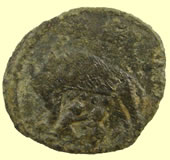
|
|||||||||||||||||||||||||||||||||
4thC Roman coin sent for ID 16.67mm, 1.41g You're correct that this coin has a Shewolf & Twins reverse which is typically found on the VRBS ROMA, City of Rome commemorative, reduced-module folles introduced around 330 AD., at the time Constantinople became the official seat of Constantine's government. These have a helmeted and mantled bust of the allegorical personification of the City of Rome facing left on their obverses. At approximately 17mm (although at 1.41gm, it's on the light side) it's most likely from the emissions of c 330-333/5, rather than the later ones of 333/5-337 which tended to be even smaller. At some mints, they were even continued as a type past the death of Constantine in 337, although often paired with a "Vota" or a GLORIA EXERCITVS soldiers & standard reverse rather than the wolf & twins. This atypical use of a subject other than an Imperial bust on the obverse was a convenient political "dodge" for cities which hadn't necessarily declared-for or been brought securely into the fold of one or another of Constantine's sons, who had some "disagreement" about who had inherited what territory or was to rule where, etc.
Unfortunately, the exergual area is too far off-flan for me to be able to make an informed guess as to the city of origin - top seriph-tips of a few letters are visible, but not enough to really be able to tell what was intended.
For a somewhat clearer view of the type, see: http://www.stoa.org/gallery/album165/52_VRBS_CYZ or: http://www.stoa.org/gallery/album165/57_VRBS_TES and as you can see from the first example, these were originally silver-washed, although the silvering very seldom survives to the present day.
Mark
|
|||||||||||||||||||||||||||||||||
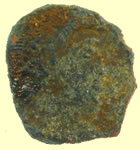

|
 
|
||||||||||||||||||||||||||||||||
| Roman bronze - sent for ID (hoard coin) 0.79g, 12.02mm Magnentius or Decentius, AE 1/2 Centenionalis, as far as I can see, it's the 2 Victories & inscribed shield "VICTORIAE DD NN AVG ET CAES" reverse. |
Roman bronze - sent for ID (hoard coin) 3.61g, 19.99mm Magnentius ("D N MAG..." visible at 8:00 - 10:00 obverse) Mint mark obscured by dirt. Reverse type: VICTORIAE DD NN AVG ET CAES - 2 Victories hold shield inscribed: VOT / V / MVLT / X. |
||||||||||||||||||||||||||||||||
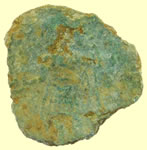
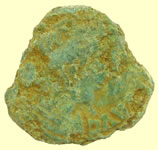
|
 
|
||||||||||||||||||||||||||||||||
| Roman bronze - sent for ID (hoard coin) 3.60g, 19.44mm Magnentius 360-363, AE Centenionalis. Mint mark off-flan or obscured, Reverse type: FELICITAS REIPVBLICE. Emperor standing left holding Victory on globe and labarum (standard with Chi-Rho on banner). |
Roman (non hoard coin) - sent off for ID 17,21mm, 2.11 (Please bear in mind this must, at best, be an educated guess) Claudius II, "Gothicus" 268-270 AD. Billon antoninianus. Reverse type: Felicitas Temporum (?) standing left holding caduceus (?) and scepter. This might be one of a number of other personifications or deities standing and holding a scepter (Jupiter, Libertas, Providentia, among others), but this resembles a plate coin in RIC |
||||||||||||||||||||||||||||||||
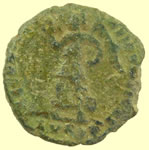
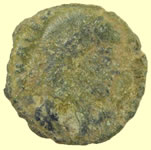
|
 
|
||||||||||||||||||||||||||||||||
| Roman (non hoard coin) - sent off for ID 2.38g, 17.10 Valens, 364-378 AD, AE3, Mint of Lyon - LVG.P, 364-7 AD. Reverse type: SECVRITAS REIPVBLICAE, Victory walking left holding wreath and palm. |
|||||||||||||||||||||||||||||||||
|
NH Scott's 6 Roman's
Mass Bruce's Roman |
|||||||||||||||||||||||||||||||||
| Unless I am mistaken, all 7 of these belong to the brother team of Magnentius & Decentius - a fairly short-lived (350-353 AD) Augustus/Caesar pair of the sort promoted to Augustus, ad-hoc, by their legions. This was a very common story during the chaos-years of the later 3rd century, but happened far less often in the 4th. Magnentius had been a top general of Constans' - his army proclaimed him Augustus and since Constans did him the favor of being captured and executed conveniently quickly - within a few months - Magnentius was duly recognized as Augustus in most of the Western provinces in 350. The next year he elevated his little brother Decentius to be his colleague Caesar.
Constantius II was not pleased by the Western upstarts and within 2 years had defeated them in a couple of significant battles. Realizing the jig was up, they both committed suicide in 353.
Although these reverse types are known for other rulers (for whom they are pretty rare), they are especially associated with Magnentius & Decentius, both of whom were always portrayed "bare headed" - no laurels or diadems, etc. - and both of whom sported distinctive "mullett" hairdos like you see on the clearest specimens here. Since I believe the obverse legend on that nice one of Bruce's ends in "AVG", I'd say it's most likely Magnentius. Any on which the obverse legend ends (around 5:00) in CAES, CAESAR, NOB C, or NC can safely be assumed to be Decentius.
The type with the 2 Victories resting shield inscribed: VOT / V / MVLT / X on a cippus (or just holding it between them) woul have a legend like: VICTORIAE DD NN AVG ET CAES - and was common for both of them. The large Chi-Rho Christogram reverse was used on both the centenionalis and short-lived double-centenionalis denominations - it's not really scarce, but is sought-after making it a bit more expensive for those wanting to buy one. This is a common factor in ancient coins, those with some sort of "religious" reference are always found desirable by folks who have no other interest in ancient coins, thereby driving up the prices (like the so-called "Tribute Penny" denarius of Tiberius - of which your diggers have found several - which is the most common silver coin of the early 1st century, but sells for 3-4 times as much as any other).
This pair struck only in the Western mints: Amiens, Trier, Lyon, Arles, Aquilea, Rome and Siscia
You have the Chi-Rho reverse 90º counter-clockwise out of alignment, by the way. in the left and right interstices of the Chi are "A" and "W" (Alpha/Omega). You can see these letters pretty clearly on this specimen although the "P"-shaped top of the Rho seems to have taken too much damage to be visible.
Some examples from my collection:
Magnentius: Chi-Rho double-centenionalis: http://www.stoa.org/gallery/album167/26_Magnentius_SAL_AMB
typical 2 Victories:
2 Victories from a British MD find:
a couple less-common reverses:
Decentius:
Mark
|
|||||||||||||||||||||||||||||||||


|
|||||||||||||||||||||||||||||||||
| |
|||||||||||||||||||||||||||||||||
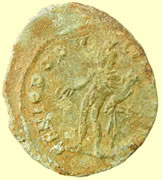
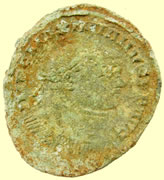
|
|||||||||||||||||||||||||||||||||
| Remarkable Roman bronze 6.99g, 28.90mm sent for ID Interesting one . There were 2 emperors who used the name "Maximianus" - one was Diocletian's colleague Maximianus "Hercules" who had a colorful career, being emperor no less than 3 times in his life and Constantine the Great's father-in-law, among other factoids. There was also his junior colleague Galerius Valerius Maximianus, generally known as "Galerius". Galerius was Caesar under Maximian, then he was Maximian Augustus in his own right during the first of the senior Maximian's abdications. He was also one of the VERY few emperors of this era who died in his own bed (albeit from a dreadful disease).
So the issue is, when faced with a coin with the obverse legend: "...MAXIMIANVS PF AVG", which Maximian do we have here, the 1st or "2nd"? - it's one case where if he'd been called "Maximian II" it would be more useful than his given name of Galerius. So, depends on when the coin was issued - and this we must discern from the sequence marks. So, we have to approach this coin from the reverse to try tell when it's from in order to know who it is. And, Voila! this coin has neither exergual mintmark or fieldmarks to help us, plus it's the extremely common reverse type of Genio Populi Romani - well, isn't that interesting? OK, then, the obverse legend is: "IMP C MAXIMIANVS PF AVG" so we turn to the list of obverse legends in RIC VI to see which mints used that form of the name - and it turns out to be all of them, no help here either. Luckily, in the plates for RIC VI, there is a photo of a GENIO POPVLI ROMANI follis with a blank exergue and fields for Lugdunum - modern Lyon.
So, this appears to be RIC VI, Lugdunum 14b - c. 296 AD. I cannot, however, be absolutely certain that no other mint issued for either Maximian as Augustus a GENIO PR follis which had no exergual or fieldmarks - absence of evidence not equalling evidence of absence and all that - without spending an absurd amount of time turning pages in a volume over 725 pages long. The findspot being Britain, however, a Western European mint like Lugdunum is quite likely.
Since Galerius, the junior Maximian, was a Caesar at this time, this must then be the elder Maximian.
Mark
|
|||||||||||||||||||||||||||||||||
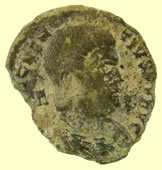
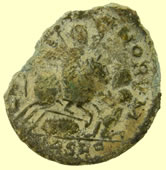
|
|||||||||||||||||||||||||||||||||
I know this one on sight - and it's actually fairly scarce. This is the short-lived emperor Magnentius. You can easily recognize him and his brother by their distinctive and somewhat silly-looking mullet hair-do's. An interesting footnote to the period of Constantius II's reign, Magnentius had been a general of Constans'. Around the time Constans died in 350 AD, Magnentius had recently been proclaimed emperor by his legions and his authority was widely accepted in Gaul and other Western Provinces, particularly in the power-vacuum caused by Constans' demise. He named his younger brother Decentius Caesar in the spring of the next year - 351. Their rule was meteoric and brief, with both of them commiting suicide after a string of lost battles in 353.
If, as you say, it's "like a typical 3rd c size" (and I'll assume you really meant 4th century here) this would be a somewhat lightweight Centenionalis, or possibly a half - RIC says "20-21mm & 5.07gm for average size & weight and doesn't list a normal half-piece, but it's not unusual for them to be found a bit on the smallish side. This reverse, GLORIA ROMANORVM, with the ruler spearing an unfortunate "barbarian" enemy from horseback, was struck only for Magnentius and not for his younger brother - and only for a short time.
This piece is from the mint at Lugdunum - modern-day Lyon in France - and dates to the period before the elevation of Decentius, so it's pretty solidly dateable to January 350 - Spring 351.
RIC Lugdunum 115, LRBC 214, SR 4021.
Mark
|
|||||||||||||||||||||||||||||||||
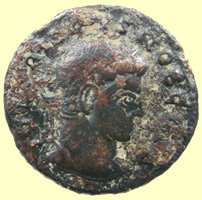 
|
|||||||||||||||||||||||||||||||||
No gold in this issue - the Romans may have used copper to debase gold (although, interestingly, unlike with the silver, they tended not to do this very much and instead struck smaller rather than debased gold coins in times of economic emergency) It certainly would have been "silvered", however - when new it would have had a wash of shiny white metal over the surface - this coating didn't last long and finding specimens of this era with any more than a trace of their silvering intact is very unusual.
This is "The Unfortunate Crispus", as history tends to style him. This eldest son of Constantine the Great by his 1st wife (before he was forced, for political reasons, to divorce her and marry Maximian's daughter) Crispus was having a brilliant career as a soldier and was extremely popular with the people. Constantine's 2nd wife (as the story goes) mother of the future emperors Constantine II, Constans and Constantius II, plotted to get rid of Crispus to clear the way for one or more of her sons to succeed Constantine. After she connived in concocting a story of rape and treason against Crispus, Constantine had him excecuted (there's some question here whether Crispus' popularity and military successes might not have been at least part of the great pragmatist, Constantine's, decision to do away with his own son).
Later, when Fausta's complicity in the plot was exposed, he had her sealed in a bath with a hypocaust beneath it, then had the fire stoked until she was boiled to death like a lobster.
This piece, from the Vota series, was struck at Siscia in 320 AD. The legends are thus:
Obv: IVL CRISPVS NOB CAES Laureate head right
Rx: CAESARVM NOSTRORVM around wreath, VOT / V within; GSIS (Siscia, 3rd officina) in exergue. RIC VII 151.
The "VOT V" is in proclamation of Crispus' undertaking the vows of his 5th year as a Caesar. The Emperor as Pontifex Maximus and "heirs apparent" Caesars as high priests of the State religion (despite Constantine and his family's official recognition of Christianity) undertook vows to perform certain ceremonies and sacrifices at various intervals (usually every 5 and/or 10 years) as sort of a bargain with the gods - "I'll faithfuly attend to doing these sacrifices for you if you'll keep me alive and in power for another 5 (or 10) years." Often appearing on reverses as merely VOT / V / MVLT / X (or X & XX, or XX & XXX, etc) within a wreath, this one honors the 3 Caesars created simultaneously 5 yrs before, Crispus, Constantine II, and Licinius II.
Mark
|
|||||||||||||||||||||||||||||||||
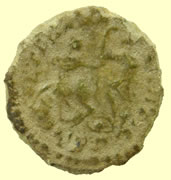 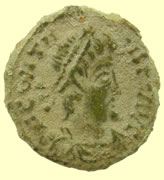
|
|||||||||||||||||||||||||||||||||
4thC Roman bronze sent for ID 16.95mm, 2.0g I believe you have a local, unofficial copy here. The type is the ubiquitous "FEL TEMP REPARATIO" ("to the return of happy times" or more broadly: "Happy Days are Here Again!") showing a Roman foot-soldier spearing an unfortunate, un-horsed "barbarian" or Persian cavalryman - wishful thinking at best that a Roman infantryman could unhorse and kill a Persian armored cataphract or German cavalryman - but it was a powerful bit of propaganda well suited to its times in which the Roman army was increasingly being shown not to be invulnerable to the "barbarians" on the borders or to the omnipresent antagonist in the East - the Persian Empire. |
|||||||||||||||||||||||||||||||||
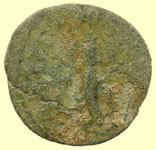 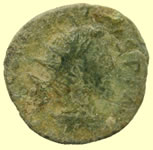
|
|||||||||||||||||||||||||||||||||
3rdC Roman bronze coin sent for ID 16.91mm, 2.25g This one appears to be an AE Antoninianus of Tetricus I - or a contemporary copy of one. As encrusted as this is, and with so little of the legends readable, I probably can't say a lot more about it. I can't be sure about the reverse type, but PAX AVG is a really common reverse type for both the official issues (of the Gallic Empire) and the local copies. This one looks as though it could be Pax as easily as any of the other, common standing personification reverse types.
Tetricus' dates were 270-273 AD - when, after surrendering to Aurelian, ceding "his" Gallic Empire back to Rome, and encouraging his troops to join with Aurelian's legions, he and his son, instead of suffering the normal fate of "rebels" (the actual rebellion had taken place 20 years earlier under a whole different generation of rulers), were brought back to Rome to march in Aurelian's triumph and were taken care of in great style, being made honorable members of the Senatorial class for the remainder of their lives.
If it is a "contemporary copy", and contemporary copies are very commonly found in the UK and northern France, it could be up to 2 or 3 years later, but the old theory that these so-called "barbarous radiates" (a term I neither like nor use) date to the time after the Romans abandoned Britannia has been thoroughly disproved by recent archaoelogical evidence of hoards and even "forgers' tools" dating specifically to the era of 270-275 or so. It can be relatively difficult to tell the difference in some cases between official pieces and local copies - some, however, belong to the "minim" class and can be found as small as 8 or 9 mm - others distinguish themselves by their extreme crudeness.
Mark
To give you an idea of the breadth of difference possible between official and unofficial
here's a specimen that's almost certainly official:
Another official piece and another potential reverse type yours might be:
Here's one that's might be official or might be a copy:
and here's one about which there can be almost no doubt that it's a contemporary copy:
And here's an example of just how bad the copies can be:
|
|||||||||||||||||||||||||||||||||
4thC Roman bronze sent for ID16.26mm, 1.97g This is Valentinian I, 364-375 AD, the co-founder of the Valentinian Dynasty along with his brother Valens, the same Valens who was killed in what was possibly the worst defeat ever suffered by Rome in a single battle - the massacre at Hadrianopolis in 378 - in which "the Goths rode-down the flower of the Roman legions" and virtually annihilated the Roman army in a single battle. Things were mostly downhill for the Western Empire from this point onward, and only 32 years later, the Goths would sack Rome during the lackluster rule of Honorius. About the best that could be said about Valentinian I is that he was lucky enough not to live to see his brother's great defeat.
The reverse type is GLORIA ROMANORVM and shows "the Emperor" walking right dragging a "barbarian captive" and carrying a labarum - a standard with the Chi-Rho symbol on it.
This type, and the companion SECVRITAS REIPVBLICAE, walking Victory AE3's, were struck in vast numbers at all the Roman mints throughout the joint reigns of Valentinian I, Valens and Gratian, Valentinian's son, from 364 until about 383 AD.
Mark
|
|||||||||||||||||||||||||||||||||
 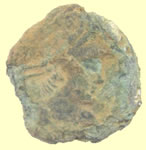
|
|||||||||||||||||||||||||||||||||
4thC Roman bronze sent for ID You're generally correct, but in addition to Constantine I himself, these were struck for the whole Constantinian gang, including a couple nephews who are hardly more than footnotes in the Imperial line. We won't be able to tell for whom this one was struck since none of its obverse legend survived, but since it's a single-standard GLORIA EXERCITVS it can be dated to the period of 335-345 AD. The single-standard types were struck for Constantine, and for his sons when they were Caesars as well as for his sons after his death when all three became Augusti in their own right.
After the FEL TEMP REPARATIO - Soldier spearing fallen horseman type which followed this type, the GLORIA EXERCITVS - soldiers and standard(s) is probably the 2nd most common coin-type of antiquity.
Mark
|
|||||||||||||||||||||||||||||||||
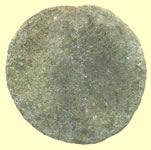 
|
|||||||||||||||||||||||||||||||||
Roman bronze coin with animal on reverse - sent for ID |
|||||||||||||||||||||||||||||||||
 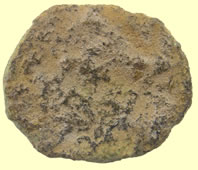
|
|||||||||||||||||||||||||||||||||
4thC Roman bronze 3.75g, 22.09mm All I'm gong to be able to do with this one is give your some general info on the period - I won't be able to assign this one to a specific ruler, but I can place it in a fairly tight time-frame. This is either a very late antoninianus or its successor under Diocletion's reforms, the purely AE "Post-reform Radiate" which was a fraction of the new "flagship denomination" the Follis. Since the basically AE radiate Antoninianus had been virtually the only coin in circulation for the 25 or 30 years prior to Diocletian's reforms, it is assumed that the general familiarity with this coin-type was the reason that a coin of this type was carried-over into the new system, looking almost exactly like the old ones This is probably either Diocletian or Maximian - the first two emperors in the administrative partnership which soon became the Tetrarchy. The reverse appears probably to be CONCORDIA MILITVM - which was a very common reverse for both the late Antoniniani and the Post-reform Radiates. Both denominations, nearly indistinguishable from each other, are typified by the radiate crown (crown of Sol or Helios) worn by the emperor on the obverse. The reverse of this one has (I believe) two figures clasping hands or one giving the other a small Victory-figure on a globe. This will usually be the emperor on the left receiving the Victory from Jupiter on the right - or occasionally a more allegorical scene of the emperor clasping hands with a figure representing, in some way, the armies. Diocletian became emperor in 284 AD, at the end of the political and monetary chaos of the 3rd century. He soon - in 286 - added Maximian as his co-emperor. The bulk of his monetary reforms were accomplished in the early 290's AD, so this coin is from the approximate period, 285-300 AD. Mark |
|||||||||||||||||||||||||||||||||
 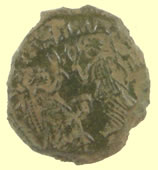
|
|||||||||||||||||||||||||||||||||
4thC Roman bronze -13.75mm, 1.08g This type was struck c. 347-348 AD. It was the last series before the monetary reform which brought in the ubiquitous and lengthy series of FEL TEMP REPARATIO "soldier & fallen horseman" types in various sizes (and other, less common FEL TEMP types) Struck by both Constantius II and Constans, I don't think we're going to be able to tell which of the two this is. With not a single letter of the obverse legend still on the coin due to edge-chipping, there really isn't any other way to discriminate between the 2 brothers. The reverse type is 2 confronted Victories holding wreaths with the legend being VICTORIAE DD AVGG Q NN ("Victory! [to] our masters the two emperors") - this type has occasionally been described as: "2 Angels playing tennis (or ping-pong)" by young students in the ACE program (the educational concern for which I work) who are asking for help in ID'ing their 1st Roman coin.
The mint mark is similarly lost - or never made it onto the coin to begin with - these being struck quickly in large numbers and rather carelessly in general. But this type was only struck in mints on the European continent, so Rome, Trier, Arles, Lyon, Siscia, etc. are the most likely points of origin.
Mark Lehman
|
|||||||||||||||||||||||||||||||||
 
|
|||||||||||||||||||||||||||||||||
3rdC Roman bronze sent for ID
2.06g, 18.90mm This piece also appears to be a DIVO CLAVDIO / CONSECRATIO posthumous antoninianus of Claudius II, c. 270 AD, and also seems to be of the altar reverse type, although you can see that the style of the altar is vastly different on this than on the last one. These commemoratives were struck by his short-lived successor, his younger brother Quintillus - but he was so short-lived (some sources say only a few weeks) that it seems unlikely that the huge posthumous commemorative series for Claudius II was accomplished during his reign, so it assumed these types (there are also common eagle reverses and some showing a funeral pyre) continued to be struck in the early months of Aurelian's reign. |
|||||||||||||||||||||||||||||||||
 
|
|||||||||||||||||||||||||||||||||
3rdC Roman bronze , 1.28g, 15.95mm It appears to be a posthumous commemorative antoninianus of Claudius II Gothicus. He inherited the chaos at Gallienus' death. A soldier-general under Gallienus, he did fairly well during his rule, considering what he had inherited, winning several crucial battles, but plague had been brought into Europe by the Goths whom he defeated at Naissus - he was among the Romans who contracted and subsequently died of the plague - after only 2 years of rule - in 270 AD.
The "CONSECRATIO" series of posthumous commemoratives in the name of "DIVO CLAVDIO" - the deified Claudius - was huge, and was also the prototype for an equally enormous, or possibly greater number of unofficial issues copying them. Workmanship had slipped so badly, and the size of coins had been reduced so much at the mint in Rome that it is not at all easy to be certain in many cases whether a piece is official or imitative.
This appears to be either an official issue, or a better-than-averge imitative of the CONSECRATIO series showing an altar on the reverse. All we have to go on, however, is the fairly distinctive, bearded portrait and the straight lines on the reverse there isn't enough clear legend to read at all. Very few reverse subjects in this era were not curvilinear - so with straight lines, an altar is all I can think this was supposed to be. -
See: http://www.stoa.org/gallery/album106/ML_13_Claud_II_Consecratio_Altar1 for a presumed official issue and: http://www.stoa.org/gallery/album106/ML_19_Claud_II_Consecratio_Altar6 for a presumed contemporary copy, and: http://www.stoa.org/gallery/album106/ML_15_Claud_II_Consecratio_Altar3 for a fairly certain contemporary copy - you can see how little diffference some of the imitatives show from the official issues the copy.
Mark
|
|||||||||||||||||||||||||||||||||
 
|
|||||||||||||||||||||||||||||||||
3rdC Roman bronze sent for ID reverse appears to be Fortuna (as on your Hadrian denarius), but standing left with her left hand on the handle of a rudder. This is a little unusual, since it's usually her right that rests on the rudder. At any rate, this leaves us right out of saying it's from the Constantinian age - Fortuna was not on the short list of formulaic reverse subjects used in the 4th century - so it must be a 3rd century product. I would guess that it is official, from the quality of the engraving, but I'm still uncertain about who's on the obverse - call it "latter half of the 3rd century, probably an official antoninianus of an uncertain ruler" and that would be about as close as I can get it. |
|||||||||||||||||||||||||||||||||
 
|
|||||||||||||||||||||||||||||||||
Easy one, this is either an official issue, or a somewhat-better-than-average contemporary copy (of the sort referred to in a rather arch and pejoritive manner by our Victorian forbears in the numismatic field as "Barbarous Radiates") of a Tetricus I AE antoninianus. The reverse type of PAX AVG has Pax standing left holding an olive-branch and transverse scepter. The obverse legend is somewhat unclear, but would probably be IMP C TETRICVS PF AVG or something very similar.
and also with:
Here you can see how broad the range of style is within these issues and types - some of the ones "on the edge" are just a judgement call as to whether they're to be called copies or official - with some, there is no doubt that they're unofficial.
If official, the mint would likely be Cologne or Vienne (Gaul, not Vienna / Vindabona), 272-3 A.D. and be at least very similar to SR11243. If a contemporary copy, it would date to the same basic time-frame, possibly plus a year or two (up to around 274 and Tetricus' capitulation to Aurelian) but the mint-site, of course, would be unknown.
Mark
|
|||||||||||||||||||||||||||||||||
 
|
|||||||||||||||||||||||||||||||||
Roman minimus well, I'm afraid I can't make any sense out of the dominant design element. This one I was fairly certian was unofficial, and the reverse tends to reinforce this opinion. The reverses were cruder, in general, than the obverses, and not unlike the Celtic coins of an earlier century, the types tended to break down to salient design elements which suggested the reverses of official coins - the looping left arm of Spes hitching her skirt, the outstretched right arm with olive-branch of Pax, etc. what remains here is surely supposed to suggest a common reverse subject, but which one, I just can't say.
Mark |
|||||||||||||||||||||||||||||||||
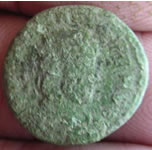 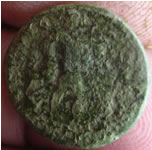
|
|||||||||||||||||||||||||||||||||
Aurelian - 270-275 A.D
|
|||||||||||||||||||||||||||||||||
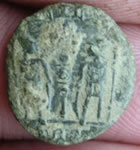 
|
|||||||||||||||||||||||||||||||||
Constantine 335-337 A.D 1.38g, 14.06mm is another GLORIA EXERCITVS - this one is from the mint at Trier, although I can't tell you which of the Constantinians is on the obverse. The ones with a single standard between the soldiers date mostly to the period 335-337 A.D. or shortly thereafter. This is probably one of the 3 sons of Constantine, probably as Caesar just before Constantine's death. |
|||||||||||||||||||||||||||||||||
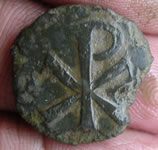 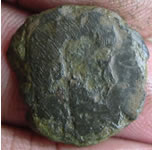
|
|||||||||||||||||||||||||||||||||
Magnentius ID 3.28g, 19.93mm This one is either Magnentius or Decentius again - and again, no legend is visible so there's no way to be sure which of the two it is, although Magnentius is a good bit more likely. This is another Centenionalis, and shows clearly the sympathies of the Western Augustus and Caesar for Christianity - there was a good bit of disagreement over just how good an idea Constantine's choice of Christianity was at the time. The Chi-Rho reverse on this and the contemporary double-centenionalis left little doubt about the official position of Magnentius & Decentius. |
|||||||||||||||||||||||||||||||||
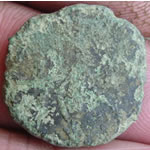 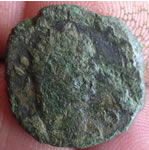
|
|||||||||||||||||||||||||||||||||
Gallienus 260-268 A.D 2.49g, 20.72mm 'is a
mid-late 3rd century AE antoninianus. The denomination was introduced,
in good silver, in 215 by Caracalla - it contained one and one-half
denarius' worth of silver but was tariffed as 2 denarii - things only
got worse from there. Quickly debased, by the time of the crisis of
the 260's, it was completely copper with a silvery wash (which seldom
survives). The later 3rd century "Illyrian" emperors like
Aurelian and Probus restored the coin to a better size and alloy,
and although still silver-washed, the process was better so it stuck
better. Eventually, it was phased out in Diocletian's reforms in the
late 280's, but a new, wholly AE "radiate" fraction of the
follis was retained with exactly the same reverse types as the former
antoniniani. I guess everyone was so used to having copper radiates
that they just continued the general module as a different denomination. |
|||||||||||||||||||||||||||||||||
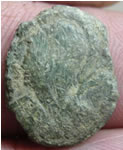 
|
|||||||||||||||||||||||||||||||||
1.65g,
16.19mm
'This is a "City
Commemorative" - when Constantine moved his capitol to Constantinople
in about 330 A.D., he issued coins in honor of both Constantinople
and of Rome. This one is the CONSTANTINOPOLIS type with |
|||||||||||||||||||||||||||||||||
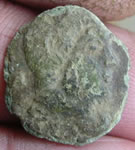 
|
|||||||||||||||||||||||||||||||||
Magnentius 350-353 A.D 1.57g, 17.71mm This
seems to be either a centenionalis which has been extensively chipped
making it smaller than it started out, or perhaps it's a half-centenionalis.
Since none of the obverse legend remains, it could be either Magnentius
or Decentius and I won't be able to tell which of the two (although
Magnentius' coins are far more common). This |
|||||||||||||||||||||||||||||||||
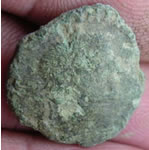 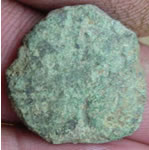
|
|||||||||||||||||||||||||||||||||
Severus Alexander 222-235 A.D. This one is an As too, but has neither enough legend nor a characteristic enough portrait for me to be sure which of the two most likely candidates it is, but I believe it's either Severus Alexander 222-235 A.D. or Gordian III, 238-244. Both were "boy emperors" who came to the throne in their teens and were both around a relatively long time as mid 3rd century emperors went - long enough for there to be a significant body of coins for both of them. Also, the one letter on the obverse which appears to be clear seems to be an "A" - and could fit into either of their names in about that position. I'm afraid I can't tell what's happening on the reverse of this one. Sorry I can't give you much more than that on the basis of the photos. 3.36g, 20.26mm |
|||||||||||||||||||||||||||||||||
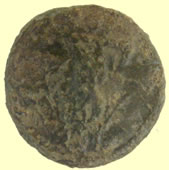 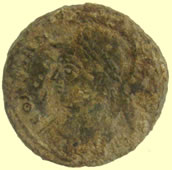
|
|||||||||||||||||||||||||||||||||
4thC Roman bronze coin sent for ID If you will recall the paragraph I wrote recently on the VRBS ROMA / Shewolf type, this is one of the CONSTANTINOPOLIS / Victory-on-prow companion types - the two city commemoratives of 330-335 for both Constantine's new capitol at Constantinople and the Eternal City (so those Romans wouldn't feel too slighted by the move). Mark |
|||||||||||||||||||||||||||||||||
 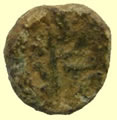
|
|||||||||||||||||||||||||||||||||
Tiny Roman minim Roman bronze - sent for ID This appears to be one of the 4th/5th century copies of Constantinian-era types. I'm not certain which type was intended here (a little cleaning might make the reerse a little clearer) but those most often used as prototypes were the GLORIA EXERCITVS Soldiers and standard(s) types and the FEL TEMP REPARATIO - Soldier spearing fallen horseman type. As the Roman administration first began "thinning-out" and eventually left the island altogether, "well-civilized" - ie: Romanized - areas tended to continue producing their own coins to attempt to continue or revive the trade of the Roman era. Eventually the feudal economic system replaced all free-market trade and small-change coins were no longer necessary. There were no longer any good to be bought by folks - nor did anyone but the top echelons of society have the freedom or wealth to make this possible or necessary. These minims represent the brave attempts of the last few outposts of the old civilization in holding-out as long as they could against the chaos which filled the power-vacuum left by the Roman administration in abandoning the island. Mark |
|||||||||||||||||||||||||||||||||
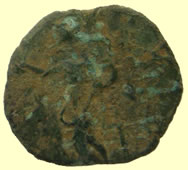 
|
|||||||||||||||||||||||||||||||||
4thC Roman Radiate coin sent for ID This one, even with no legend visibly apparent at all, I actually feel confident to tell you is an official issue (Mint at Vienne?) Tetricus I / PAX AVG billon antoninianus (270-273 AD). Compare this one to: http://www.stoa.org/gallery/album110/ML_06_Tetricus_I_Pax_ant2 Mark |
|||||||||||||||||||||||||||||||||
 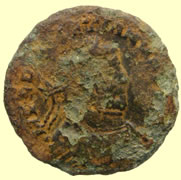
|
|||||||||||||||||||||||||||||||||
4thC Roman bronze sent for ID 7.67g, 25.48mm What you have there is either a pre-reform billon (originally silvered) antoninianus or a post-reform "radiate" fraction of a follis - of a very similar design (for the sake of familiarity, and at the same general value, it's assumed) to the old antoniniani, but with no pretense of containing silver. Diocletian ruled from 286-305. Most of his monetary reforms were accomplished in the early 290's, so if it's an antoninianus (and if it is, it will have "21" in some notation - generally in the exergue and in Roman Numerals - like "XXI") it dates to 294 or prior. The post-reform radiate follis fractions date to 294 and later. Mark |
|||||||||||||||||||||||||||||||||
 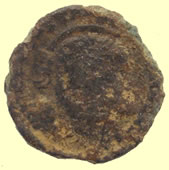
|
|||||||||||||||||||||||||||||||||
4thC Roman bronze coin sent off for ID Although I can't tell you who's on the obverse - these were struck for Constantine I, Licinius I, Crispus & Licinius II at the very least and perhaps a couple other folks whom I'm not remembering - this is what's referred to as a "VLPP" - an abbreviation of the long reverse legend - "VICTORIAE LAETAE PRINC PERP" and has 2 Victories facing each other resting a shield inscribed VOT/PR on a short cippus (column, or plinth) or altar. This is a helmeted-bust Constantine I from Ticinum, known official - http://www.stoa.org/gallery/album164/02_Constantine_I_VLLP_TIC This is one of the cruder contemporary copies - it's obvious that there was no attempt being made to fool anyone - this was a de-facto "official" coin in its place of origin, not a "counterfeit" of any sort, made to deceive. If you can clean this up a bit, I should be able to tell if A- it's official, and B- who's on the obverse. Mark |
|||||||||||||||||||||||||||||||||
  |
|||||||||||||||||||||||||||||||||
Shewolf & Twins reverse which is typically found on the VRBS ROMA, City of Rome commemorative, reduced-module folles introduced around 330 AD Sent to Mark Lehman for confirmed ID So far as I can see in this state, it appears to be a completely normal VRBS ROMA city commemorative. It's a little unusual in not being as badly corroded as many British surface finds. At the size/weight, it probably dates to the 2nd period of production 335-337 (as late as 340 in some places). So far as I am able to speculate on the mint mark - based on what is currently visible plus the historical distribution of mints for the pieces found in Britain - it appears to be a Trier mint mark I think it's TR•P or TR☼P (with a dot or star in the 3rd position - the "P" in final position is the officina designation) Mark 2.15g, 17.19mm |
|||||||||||||||||||||||||||||||||
Mid 4thC House of Constantine Roman bronze coin - two soldiers standing |
|||||||||||||||||||||||||||||||||
 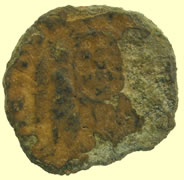
|
|||||||||||||||||||||||||||||||||
Magnentius & Decentius - a fairly short-lived (350-353 AD) Augustus/Caesar pair of the sort promoted to Augustus, ad-hoc, by their legions. This was a very common story during the chaos-years of the later 3rd century, but happened far less often in the 4th. Magnentius had been a top general of Constans' - his army proclaimed him Augustus and since Constans did him the favor of being captured and executed conveniently quickly - within a few months - Magnentius was duly recognized as Augustus in most of the Western provinces in 350. The next year he elevated his little brother Decentius to be his colleague Caesar.
Constantius II was not pleased by the Western upstarts and within 2 years had defeated them in a couple of significant battles. Realizing the jig was up, they both committed suicide in 353.
Although these reverse types are known for other rulers (for whom they are pretty rare), they are especially associated with Magnentius & Decentius, both of whom were always portrayed "bare headed" - no laurels or diadems, etc. - and both of whom sported distinctive "mullett" hairdos like you see on the clearest specimens here. Since I believe the obverse legend on that nice one of Bruce's ends in "AVG", I'd say it's most likely Magnentius. Any on which the obverse legend ends (around 5:00) in CAES, CAESAR, NOB C, or NC can safely be assumed to be Decentius.
The type with the 2 Victories resting shield inscribed: VOT / V / MVLT / X on a cippus (or just holding it between them) woul have a legend like: VICTORIAE DD NN AVG ET CAES - and was common for both of them. |
|||||||||||||||||||||||||||||||||
Mid 4thC Roman bronze coin sent for ID This appears to be a CONSTANTINOPOLIS city commemorative. As the move of Constantine's seat of government to Constantinople was about to be implemented and become official in 330 AD, a very large emission of city commemoratives for both Rome and the new Capital was issued at the same time as the very common and familiar pieces with a portrait of a Constantinian family member and GLORIA EXERVITVS soldiers and standard(s) reverse. The VRBS ROMA commemoratives showed a similar armored bust of the personification of the city of Rome and had the shewolf suckling the twins Romulus & Remus on its anepigraphic reverse. Mark
|
|||||||||||||||||||||||||||||||||
4thC Roman bronze coin sent for ID This is a so-called "campgate" (probably actually a signal tower) reverse. The mint mark - in exergue - is clearly London. The legend on the reverse is almost totally gone, but it appears to end "...SS" meaning it would more likely be the PROVIDENTIAE CAESS than the PROVIDENTIAE AVGG legend, of the 2 types most commonly found on these. So the greatest likelihood that it is Constantine II or Constantius II (less likely) although Crispus (I think) is also a possibility. Constantius II only got in on the tail end of the campgate period just as Crispus only made the earliest part. This dates to the 320's - mostly the later 320's, although, as I said, Crispus (d. 324) did get in on the very beginning of the type.
|
|||||||||||||||||||||||||||||||||
 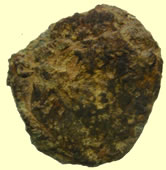 |
|||||||||||||||||||||||||||||||||
Just a W.A.G. (as we academic types say...) this might be a SALVS REIPVBLICAE reverse from the later Valentinian Dynasty era. (Valentinian II, Theodosius I, Arcadius - 383-393 AD) I can't tell which of the 4 possible emperors it might be, however. At least this seems to be the most likely reverse type - this makes this one of the latest Roman coins I can recall you finding. Mark |
|||||||||||||||||||||||||||||||||
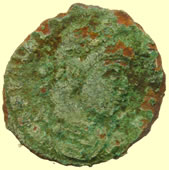  |
|||||||||||||||||||||||||||||||||
4thC Roman bronze coin sent for ID This is Valentinian I - 364-375 AD - the type is SECVRITAS REIPVBLICAE with Victory walking left holding wreath and palm. This is one of the most common types from the time immediately following the Constantinian era. If you were to do a little brushing around the exergual area, we might be able to tell from the mint mark where it was struck. Mark |
|||||||||||||||||||||||||||||||||
3rdC Roman coin sent for ID 22.22mm, 3.55g Remember the "hoard" you had last year which included a dozen or so pieces from the short-lived Magnentius and his brother Decentius? - This is another of those - it even seems to have nearly identical plow-soil damage, edge chipping and surface and degradation as those displayed. It's probably Magnentius since his coins are somewhat less scarce than those of his shorter-lived brother - both were portrayed with similarly dopey facial expressions and equally dopey haircuts. The reverse shows 2 Victories holding a shield inscribed VOT / V / MVLT / X between them - the reverse legend should be VICTORIAE DD NN AVG ET CAE or very close thereto. Magnentius was Augustus in parts of the west from 350 to 353 at which time he and his brother, whom he'd made Caesar in 351, were defeated by Constantius II and committed suicide rather than being captured, imprisoned and eventually dishonorably executed by Constantius. Mark |
|||||||||||||||||||||||||||||||||
4thC Roman coin sent for ID 13.36mm,1.41g This little guy appears to be a contemporary copy Æ radiate from the period 260-270 AD. The size is too small and the weight too low to be an offical anything. The design is a mish-mash of bits from several protoypes. The obverse legend is blundered at best - if not totally illiterate - so it's uncertain who is intended. The portrait seems not to be meant to resemble anyone in particular, although it is far less crude and cartoonish than many of these. The reverse seems to be modeled on the ADVENTVS reverses common to Tetricus and Claudius II Gothicus which show the emperor on horseback left, walking or prancing, raising right hand. This is a really unusual reverse for one of these so-called "barbarous radiates" - I don't think I've ever seen one with an equestrian reverse before - but it's an unusual day in this field that you don't learn or see somethng new. Mark |
|||||||||||||||||||||||||||||||||
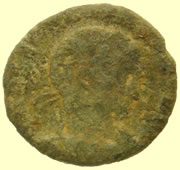 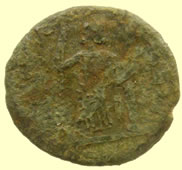 |
|||||||||||||||||||||||||||||||||
4thC Roman bronze sent for ID You seem to be findingt a lot of contemporary copies these days. This is almost certainly the product of an "unofficial" mint around 315-320 AD. I am a little stumped, however, as to just what sort of coin was used as a prototype for this. It seems a little like the earlier 4th century late-issue folles of the Licinii (some were struck for Constantine & family, but the Licinii are far more often represented) of the "IOVI CONSERVATORI" series. Those will have Jupiter standing left and generally holding a small figure of Victory in right hand and resting on a scepter with his left. An eagle and/or a bound captive might appear at his feet or the Victory might be replaced with a thunderbolt, etc. This is an example of a common type of IOVI CONSERVATORI piece which might have served as a prototype, but placing the scepter in the right hand on yours - although Constantine is more usually portrayed with a Sol reverse (SOLI INVICTO COMITI) during this time period http://www.stoa.org/gallery/album162/49_Constantine_I_Follis_312_13_ICA_TES This is an example of a far more commonly encountered Licinius/IOVI late follis http://www.stoa.org/gallery/album162/56_Licinius_I_Follis_315_16_ICA_HER Alternately, the prototype might have been one of the PRINCIIPIA IVVENTVTIS types of Crispus, Consatntine II and Licinius II Caesars. http://www.stoa.org/gallery/album164/09_Crispus_PI_ARL_AE It could be a "fantasy" reverse based loosely on all the various standing deity/Imperial reverses of the era and not meant to really copy any one of them. Interesting piece - I've never seen a contemporary copy of this sort - although the same era saw prolific local copying of the VICTORIAE LAETAE PRINC PERP 2 Victories pieces in the Balkans. Perhaps the conflict between the Constantinian family/party and the Licinii and their supporters interrupted Imperial coin supplies to Britain at the same time as they did in the Balkans. That's just a guess, however. |
|||||||||||||||||||||||||||||||||
4thC Roman bronze coin sent for ID 2.12g, 18.76mm The second is a "restored Centenionalis" (some call this piece a "Majorina" and the former type a "Centenionalis", so there is lots of room for confusion regarding the denomination-names here) most likely of either Valens or Valentinian I (364-378 / 364-375 respectively). This has the reverse type of Victory walking left carrying a wreath and palm-branch and the legend SECVRITAS REIPVBLICAE. This type was struck - alongside of the equally common GLORIA ROMANORVM reverse with emperor dragging a captive - throughout the 364-378 period by both of the brothers (Valens & Valentinian I) as well as for Gratian, a son of Valentinian I who was raised to Augustus by Valentinian in 367 and then took his place after he was killed at Hadrianopolis, and briefly for Valentinian II, a much younger (in order to protect the dynastic succession, he was raised to Augustus as an infant) half-brother of Gratian. Although the exergual mint mark is illegible in this photo, both of these very common "Æ3" types tended at most mints to employ a complex system of sequence or privy marks in the reverse fields in addition to the exergual mintmarks. Using a spreadsheet of right field/left field combinations to check the possible mints which used a D in the left reverse field (and nothing in the right field), we find this can only have come from the mints of Trier, Aquilea or Siscia. Those which were struck for Valentinian I (or brother Valens) can only have come from Aquilea or Siscia - so that narrows it down a bit. The obverse legend is very weak and fragmentary (as you can see) so if I was wrong about who's on the obverse and it is, in fact, Gratian, (although the first letter of the name looks more like a "V" than a "G" to me) then there is a possibility it's from Trier - in fact, for Gratian, it could only be Trier or Siscia. Since Valentinian II was only a child during almost his entire "reign" (regency) his portrait is always shown much smaller than the portrait on this piece - so he's not a possibility, making this determination slightly less complicated. Mark
|
|||||||||||||||||||||||||||||||||
4thC Roman bronze coin sent for ID The city commemoratives - in honor of both Constantinople and Rome - are contemporaneous with the ubiquitous GLORIA EXERCITVS, 2 soldiers flanking 1 or 2 standards issues. Each has an allegorical representation of the city - as a relatively similar-looking helmeted and armored woman - facing left on the obverse - one has the legend, CONSTANTINOPOLIS, the other, VRBS ROMA. The Constantinople type had an anepigraphic reverse showing Victory, carrying spear and shield, in the prow of a galley. The Rome version has the anepigraphic Shewolf & Twins reverse. These two types were introduced in 330 AD to announce/commemorate Constantine the Great's re-founding of the city of Byzantium as Constantiople, his new Imperial capital. Both types were struck until his death in 337, and the obverses were resurrected with single-standard Gloria Ex reverses at a number of eastern mints in the late 330's and early 340's. Mark
|
|||||||||||||||||||||||||||||||||
Mid 4thC Roman coin sent for ID This one I can tell where it was minted with a lot more certainty than I can tell you who is on the obverse and what the exact reverse type is. - The exergual mintmark is quite clearly that of Aquilea - S]MAQ[S - Sorry I can't be more specific than this, but the legend fragment on the obverse is just too illegible and the reverse legend virtually does not exist. Mark
|
|||||||||||||||||||||||||||||||||
4thC Barbarious radiate Roman coin sent for ID This is a fairly well-preserved specimen of contemporary radiate copy. You say "little" and so I assume that it's small enough that even aside from the crudeness of the workmanship, there can be no rational question of it was ever having been intended to fool anyone into thinking it was an official-issue Roman piece - in other words, deception was never the intention of the makers of this piece. This is an important concept to understand with these pieces - they are by no means what we'd call "counterfeits" - they're more of an emergency currency issued to take the place of official coin which has disappeared from circulation due to hoarding, export, or the small but steady and inevitable attrition of pieces lost and not recovered (until now). The Imperial coin is no longer being regularly replaced due, generally, to a vacuum, whether temporary or permanent, of the centralized power which issues and distributes official coin - generally through the pay of soldiers and the purchase of foodstuffs and other army supplies through the local economy as its main mechanism. These so-called "barbarous" radiates were, at one time, thought to belong to the period after the withdrawal of Roman troops from Britain and northern Gaul in the 5th century, but it is becoming clear as more hoards are found and analyzed that they are virtually contemporaneous with the prototypes they emulate. The withdrawal of Italian Roman authority during the mid 3rd century and the time of the Gallic Roman Empire was both the time-frame and the reason for the existence of these pieces. The Gallic Roman Empire evidently only sporadically refreshed the local supplies of coin, since official Gallic and unofficial radiates are often found mixed together in hoards. The exact place they had and role they played in the economic life of the area is not clear. Perhaps they circulated at par with the official (but token, due to base-metal fabric) coinage, or perhaps at a discount. They may have served as something analagous to modern "plantation tokens" which were used mainly in small, closed, internal economic systems like those seen in large farms/villas or latufundia. I'm not certain to what degree the large-scale industrial agriculture model penetrated into Roman Britain, but that is a possible origin with the large Roman estate becoming somewhat of a template for the later, insular feudal units of organization. There is also the possibility that these coins were issued as military scrip (meant to be exchanged at some later date for official coin) to troops on the borders in order that a catastrophic military loss would not also mean a huge capture of "real" wealth by the enemy. I'm not completely certain what the reverse type was supposed to emulate. Although the obverse is fairly typical of the Victorinus/Tetricus "bearded radiate bust" types, the reverse type doesn't immediately "resolve" adequately into a stylized or abstract copy of any of the normal types like Pax, Victory/Comes or Spes. It is possible, even likely, that it is intended to be a Pax type with Pax facing left holding a long scepter in her left hand - the anticipated olive-branch in the right hand, however, is not visible here, so I can't be certain. An assortment of unofficial pieces found in Britain and Northern Europe can be seen grouped together here: http://www.stoa.org/gallery/album476 you may draw your own conclusions as to which of these types this piece most closely resembles. Or you can look at the official types of the era here: http://www.stoa.org/gallery/album110 to try to see what it may have been intended to emulate. Mark
A tiny sweet little Roman 4thC Barbarous radiate coin sent for ID Looks like ET on reverse !! 0.67mm,10mm A very nice example of the fully devolved form. Also, I know I've subjected you to my opinions on this subject before and although I know I'm unlikely to change the world which uses this terminology, but just to reiterate, "Barbarous Radiate" is a terribly incorrect and inappropriate name for contemporary copies of this nature. These contemporary copies were made and used by people who were not only no more barbarous than than those who made the originals which served as protype, they were made and used by the same people. Folks who are unaware of the difference in meaning between the words: "barbarous", "barbaric", "barbarian" (most people, these days, it appears) seem to have an opinion - or as a sales technique want to spread the erroneous perception - that coins of this nature were made and used by Conan of Cimmeria, or some similar scenario. In fact "barbarous" in this usage was meant as an artistic criticism of the style, made by the snobbish collectors of the 19th century whose artistic appreciation was so stunted that in their opinion anything other than standard Classical art was unworthy of their exalted notice. In fact, these changes in design are tracing a similar arc to those designs based originally on the staters of Philip II and Alexander which were the prototypes for hundreds of later types of Celtic staters. These morphed as they emphasized some parts of the design and left others out in accordance with their own artistic sensibilities. Mark
4thC Roman bronze sent for ID I can tell you what it is and give you a pretty tight date range for it, but unfortunately, I can’t pull enough information out of the legends (which appear as though they might become readable with a bit of de-crusting) to say who the portrait is supposed to represent and which was the mint city of origin.
Initially I thought this was a tiny Celtic bronze unit but it could be a 4th C Roman barbarous radiate, I have sent it to our Roman expert for his views 1.02g, 13mm Personally, I don’t like the term “barbarous” – I’d say “unofficial mint” or “contemporary copy”, but yes, this is what many would call “barbarous”. DIVO CLAVDIO / CONSECRATIO antoninianus, likely from the mint of Rome. I know, it’s a stretch at best, but that’s what you tend to get into with the contemporary copies from Gaul and Britain – some are pretty wild and at best only vaguely suggestive of their prototypes. To be fair, the official prototypes are often so crude and poorly executed that it’s, frankly, difficult to say “official” vs. “Unofficial” about many specimens.
Very unusual Roman bronze coin - sent off for ID
4th C Roman bronze coin sent for ID Constantine I, 307-337 AD Mark
4th C Roman bronze - sent for ID Constantine II, Caesar, 317-337 A.D.
osthumous commemorative BI antoninianus for Claudius II, “Gothicus”, 268-270
Typically copper, bronze, potin, or whatever alloy was available – almost never as good “silver” or billon as the originals. This one is better than most unofficial pieces. It is also likely a little smaller than the normal, official issue pieces, too, but I made the photos the same size for comparison’s sake. Ranging through levels of illiteracy many of these have had their legends reduced to abstract, decorative border elements.
“PIETAS AVGVSTOR” augur’s Implments
3rd century in this case -
4thC Roman bronze coin sent for ID It’s not possible to tell you with 100% certainty which of the Constantine clan has his portrait on this one, but I can tell you a good bit about it and make an educated guess about the person. As for that, given the position of the very few legible letters on the obverse and the clear officina letter on the reverse, I think it is probably Constans, Caesar.
Roman bronze coin used as pendant - sent for ID On the basis of what I can see I can’t give you a book reference, “chapter and verse”, but I can tell you it’s a Diocletianic follis of Maximian and the general era is 294-305 AD. Obv: IMP C MAXIMIANVS P F AVG laureate, draped and cuirassed bust of Maximian right
4thC Roman bronze coin sent for ID Crispus (“the Unfortunate…”) Caesar, 316-326 AD. Mark
4thC Roman bronze coin - sent for ID Very interesting – not a type I recall you ever encountering – at least while I’ve been looking at your Roman finds. This is a posthumous commemorative reduced billon centenionalis struck under Constantine II, Constantius II and Constans in honor of Theodora. She was the step-daughter of Maximian (and so (somewhat distantly) related to the Imperial group from the beginning). She had also been the 2nd wife of Constantius I (but not the mother of any of the Constantine clan), who had a bright, if short career in Britain and died, if I’m not mistaken, in York, er… “Eboracum”. If you’ve never heard of Theodora, you’re not alone – these aren’t exactly rare, but she’s about as obscure a cousin, stepmom, etc, as the Constantine clan ever honored on a large-production type. These date to the time-frame 337-340, immediately after the death of Constantine I and only during the brief reign as Augustus of Constantine II before his early death. They represent the three divisions into which the Empire was split by the wishes of Constantine I shortly before his death. Given what I usually see from your finds, I’d guess it’s most likely to be from Trier – although there’s no special scarcity or other defining factor of one mint over the other two. If, when you’re cleaning this, you find the exergual mint mark begins “TR…”, it’s from Trier; “R…” if from Rome or “CONS…” if from Constantinople. Obv: FL MAX THEODORAE AVG her diademed and draped bust right.
4thC Roman bronze - sent for ID I’m not saying yours is an exact match, but since the legends on it are all pfft (except for …VS… at top of reverse, so the legend here is VIRTVS AVG and the galley seems to be sailing right rather than left – they go both ways) and we won’t be able to read the mintmark (if it ever had one), this is the description for my piece: I failed to mention – but I assume you already know – that Allectus was the heir to Carausius’ British Roman Empire. Only he wasn’t quite as sharp as his predecessor and so lasted only a relatively short time before the “regular” Romans disposed of him and the incipient “Empire”. Basically, it has a strong British connection which might be completely lost on or perhaps not immediately apparent to the finder if (s)he is from elsewhere than the Happy Isles.
4thC Roman bronze coin sent for ID Constantine I, Æ centenionalis. Mint of Trier, 322 AD
it’s almost certainly Victory walking left, and I can read: REIPVBLICAE” on the right side of the reverse, so there are two types it might possibly be, a Valens centenionalis or Arcadius half-centenionalis.
Mark
4th Roman bronze barbarous radiate - sent for ID Official-issue Gallic Empire antoniniani. Basically, I think it’s likely to be an official issue, not a contemporary copy (or “barbarous” if you prefer.) Mark
4thC Roman bronze coin - sent for ID This is a centenionalis from the astronomical numbers of them, in several designs, which Constantine I approved to celebrate his move of the Imperial government seat to Constantinople.
Obv: Helmeted and mantled bust of the personification of Rome - VRBS ROMA
4thC Roman bronze coin - sent for ID - 2.0g, 18.38mm
You lucked out on this one - if I hadn't cataloged a couple of these recently I might not have recognized the SARMATIA DEVICTA centenionalis of 323-324 A.D. The reverse shows Sarmatia, walking right, carrying a trophy and palm-branch and treading-down a bound captive at her feet. Mark
Mid 4thC Roman barbarous radiate bronze coin
4thC Roman bronze sent for ID
4thC Roman bronze coin sent for ID
Magnentius & Decentius - a fairly short-lived (350-353 AD) Augustus/Caesar pair of the sort promoted to Augustus, ad-hoc, by their legions. This was a very common story during the chaos-years of the later 3rd century, but happened far less often in the 4th.
4thC Roman bronze coin - sent for ID This one's a little later than most of what you usually seem to find. It's a centenionalis of Valentinian I, 364-375 AD. Obv: D N VALENTINIANVS P F AVG diademed, draped and cuirassed bust right.
The province is Bithinia, not Mysia - working too late and shooting from the hip last night.
4thC Roman bronze coin - sent for ID Constantius II, AE majorina or fraction. FEL TEMP REPARATIO soldier skewering fallen horseman.
4thC Roman bronze coin - sent for ID Interesting that this is probably a Roman silver as you can see silver on the edges in the pictures. Are you sure this isn’t silver?– it’s too tiny and lacks the “S-C” Imperial bronze would have carried– if it’s definitely base metal, maybe it’s a so-called “Limes Falsa” copy of a denarius – they were generally cast in molds made by pressing genuine coins into clay, so they tend to be accurate in detail. It also might be a semis or qudrans of a type with which I am unfamiliar. It looks as if, with a little careful cleaning, the obverse legend (or parts of it) might be made legible. Send it again if it gets cleaned and I’ll have another stab at it 1.04g, 14.11mm
Weird Roman copper coin sent for ID Time of Constantius II (337-361 AD – Probably Constantius II, although a small number of this same type were briefly struck for Constans, Constantius Gallus, Caesar, and Julian II, as Caesar – It looks more like Constantius II – no legend showing to prove it, however. 1.3g, 16.34mm
4thC Roman bronze sent for ID Constantinian era - probably Constantine I, (306-377 AD), portrait looks like him, but legend is too unclear to be certain.
4thC Roman bronze sent for ID 2.14g, 15.55mm this is a contemporary copy of a mid-late 3rd century billon antoninianus. These unofficial pieces were very common in Britain and Gaul in the mid-late 3rd century and circulated alongside the few official pieces still in circulation at that point.
4thC Roman bronze coin - sent for ID This is a billon centenionalis issued by Constantine I to commemorate the beginning of the new Roman capital at Constantinople - it was minted as a part of the same huge emission which also features the very common "two standards flanked by soldiers" (GLORIA EXERCITVS) reverse.
4thC Roman bronze coin sent for ID Not easy to "see", but it's the she-wolf standing left, looking back at the twins, Romulus and Remus as babies, suckling.
Weird bronze coin ? This is an VRBS ROMA - with helmeted Roma facing left on the obverse and the mythic Shewolf standing left on the reverse suckling Romulus and Remus. These belong to the period 330-337 or so.
4thC Roman bronze coin - sent for ID
Mid 4thC Roman barbarous radiate coin
Mid 4thC Roman Constantine copper coin
Mid 4thC Roman bronze coin sent for ID You might call this "the last gasp of Constantine's centenionalis". Mark
Tiny Roman bronze minim
Mid 4thC House of Constantine Roman bronze coin - 2 soldiers standing
Mid 4thC House of Constantine Roman bronze coin
Mid 4thC House of Constantine Roman bronze coin - two soldiers standing
Mid 3rdC Barbarous radiate Roman bronze coin his appears to be a "garden variety" mid-later 3rd century contemporary local copy - the sort of thing which is liable to be referred to (although I hate the term) as a so-called "barbarous radiate". It's stylistically very interesting in that the stick-figure reverse device is built up out of almost all straight lines and angles, where these generally tend to be made up of curvy or loopy, freehand-engraved lines.
Shewolf & Twins reverse which is typically found on the VRBS ROMA, City of Rome commemorative, reduced-module folles introduced around 330 AD., at the time Constantinople became the official seat of Constantine's government. These have a helmeted and mantled bust of the allegorical personification of the City of Rome facing left on their obverses. At approximately 17mm (although at 1.41gm, it's on the light side) it's most likely from the emissions of c 330-333/5, rather than the later ones of 333/5-337 which tended to be even smaller. At some mints, they were even continued as a type past the death of Constantine in 337, although often paired with a "Vota" or a GLORIA EXERCITVS soldiers & standard reverse rather than the wolf & twins. This atypical use of a subject other than an Imperial bust on the obverse was a convenient political "dodge" for cities which hadn't necessarily declared-for or been brought securely into the fold of one or another of Constantine's sons, who had some "disagreement" about who had inherited what territory or was to rule where, etc.
Very interesting Roman coin - small bust and almost looks like a silver - sent off to Mark Lehman for his ID Although the obverse legend is unreadable - probably illiterate - and the portrait both faces left and seems to be radiate (the official ones were never radiate, only laureate or helmeted) given the small size of the bust, I'm going to guess this was probably based (perhaps several generations earlier) on a piece with Crispus' portrait. This is a contemporary copy of a "VLPP" (VICTORIAE LAETAE PRINC PERP - "[our] victorious, rejoicing, ruler for all time" ) centenionalis. ca. approximately 318-325
Mid 4thC House of Constantine Roman bronze coin
4thC Roman bronze sent for ID This centenionalis is so crude that I can't tell you with certainty whether it was struck at an official or an unofficial mint.(ie: a contemporary copy). Mark
Magnentius This one is either Magnentius or Decentius again - and again, no legend is visible so there's no way to be sure which of the two it is, although Magnentius is a good bit more likely. This is another Centenionalis, and shows clearly the sympathies of the Western Augustus and Caesar for Christianity - there was a good bit of disagreement over just how good an idea Constantine's choice of Christianity was at the time. The Chi-Rho reverse on this and the contemporary double-centenionalis left little doubt about the official position of Magnentius & Decentius.
They are found down to a diameter of 10-12mm with little or no legend and little detail, too The output of low denomination coins at Rome in this chaotic period tends to be so crude that it's not always possible to tell if any given specimen was the product of an official or unofficial mint.
Mid 4thC Roman copper coin sent for ID Chris, Below you'll see an example of a Tetricus I antoninianus with a Salus reverse - not necessarily exactly like your coin, but another one of the enormous number of surviving small and crude antoniniani from the chaotic period of the 2nd half of the 3rd century. Keep digging this area! - who knows whose coinage you'll find next? - there are so many possible issuers of coins in this general category which might well have been struck in, circulated in, or ended-up in Britannia. They're all quite a bit earlier than the similarly small, typical 4th century pieces you often seem to find.
|
|||||||||||||||||||||||||||||||||

|
|||||||||||||||||||||||||||||||||
